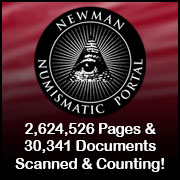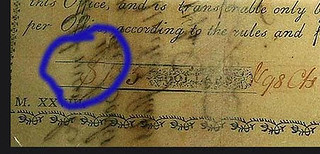
About UsThe Numismatic Bibliomania Society is a non-profit association devoted to the study and enjoyment of numismatic literature. For more information please see our web site at coinbooks.org SubscriptionsThose wishing to become new E-Sylum subscribers (or wishing to Unsubscribe) can go to the following web page link MembershipThere is a membership application available on the web site Membership Application To join, print the application and return it with your check to the address printed on the application. Print/Digital membership is $40 to addresses in the U.S., and $60 elsewhere. A digital-only membership is available for $25. For those without web access, write to: Charles Heck, Treasurer
AsylumFor Asylum mailing address changes and other membership questions, contact Chuck at this email address: treasurer@coinbooks.org SubmissionsTo submit items for publication in The E-Sylum, write to the Editor at this address: whomren@gmail.com BUY THE BOOK BEFORE THE COINSale CalendarWatch here for updates!
|
- WAYNE'S WORDS: THE E-SYLUM JANUARY 5, 2020
- KOLBE & FANNING BUY OR BID SALE NUMBER 11
- RAREPICKS OFFERS BANKNOTE BOOKS AT FIXED PRICES
- NEW BOOK: THE NUMISMATIC EDGAR ALLAN POE
- NEW BOOK: THE COIN-WEIGHTS OF IRELAND
- NUMISMATIQUE ASIATIQUE DECEMBER 2019 PUBLISHED
- BOOK REVIEW: A NUMISMATIC HISTORY OF ECUADOR
- GENE GARDNER REMEMBERED ON THE NEWMAN PORTAL
- VIDEO: LIBERTY SEATED COIN CLUB LEADERSHIP
- DUBLIN COIN ARTIST PJ LYNCH
- MORE ON JOSEPH SEGEL AND THE FRANKLIN MINT
- NOTES FROM E-SYLUM READERS: JANUARY 5, 2020
- MORE ON THE CENTRAL AMERICAN UNION PACT
- 1902 PARIS IN LONDON EXHIBITION MEDAL AWARDEE
- THE FIRST KNOWN USE OF THE WORD 'NUMISMATICS'?
- VOCABULARY TERMS: HIGH POINT, HIGH RELIEF
- EMMETT T. JOHNSON (1836-1907)
- HARVEY STACK'S NUMISMATIC FAMILY, PART 60
- THE NUMISMATIC LEGACY OF THE FRANKLIN MINT
- WORTHPOINT FOUNDER WILL SEIPPEL
- LIBRARY OF CONGRESS EARLY AMERICAN PAPER MONEY
- FRACTIONAL CURRENCY SHIELD ADVERTISER
- SAVING THE WASHINGTON FAMILY FORTUNE
- NUMISMAGRAM MEDAL SELECTIONS: JANUARY 2020
- NUMISMATIC NUGGETS: JANUARY 5, 2020
- HASMONEAN COINS UNEARTHED IN SHILOH
- RESTRICTIVE TURKEY, TUNISIA AGREEMENTS PENDING
- NATIONAL GALLERY ACQUIRES CHARLES I GOLD MEDAL
- LOOSE CHANGE: JANUARY 5, 2020
- FIGHTER JET SCULPTURE MADE OF CENTS
Click here to access the complete archive
Click here to unsubscribe (scroll down)
To comment or submit articles, reply to whomren@gmail.com
Content presented in The E-Sylum is not necessarily researched or independently fact-checked, and views expressed do not necessarily represent those of the Numismatic Bibliomania Society.
WAYNE'S WORDS: THE E-SYLUM JANUARY 5, 2020
 New subscribers this week include: J. Lavaque. Welcome aboard! We now have 6,070 subscribers.
New subscribers this week include: J. Lavaque. Welcome aboard! We now have 6,070 subscribers.
Thank you for reading The E-Sylum. If you enjoy it, please send me the email addresses of friends you think may enjoy it as well and I'll send them a subscription (but let me know if they are located in the European Union). Contact me at whomren@gmail.com anytime regarding your subscription, or questions, comments or suggestions about our content.
NBS Members: It's that time of year again - please renew your membership by check or online with Paypal. For more information, see:
https://www.coinbooks.org/about/
membership.html
This week we open with two numismatic literature offerings, two new books, a new periodical issue, a book review and updates from the Newman Numismatic Portal.
Other topics this week include Joe Segel and the Franklin Mint, coin designer PJ Lynch, the 1902 Paris in London Exhibition medal, the first use of the word numismatics, high relief, WorthPoint.com, early American paper money, and an unusual Fractional Currency Shield.
To learn more about the numismatics of Edgar Allan Poe and Ecuador, the coin weights of Ireland, collector Gene Gardner, Franklin Mint casino tokens, the Central American Federation coin patterns, prize-winning handkerchiefs, the Hobby Protection Act, the story of Pygmalion, the Bank of Zilchy, the Penny Plane, Cato the cash-sniffing dog, Mrs. Burke's unmentionables, Miss Sarah's egg basket, and the Washington family fortune, read on. Have a great week, everyone!
Wayne Homren
Editor, The E-Sylum
KOLBE & FANNING BUY OR BID SALE NUMBER 11
Numismatic Booksellers Kolbe & Fanning submitted this announcement of their eleventh "Buy or Bid Sale" which closes on January 13, 2020. Good luck, everyone! -Editor
Buy or Bid #11 Opens
 Kolbe & Fanning Numismatic Booksellers have announced our eleventh “Buy or Bid Sale,” which begins now and will close on Monday, January 13, 2020. With hundreds of
new additions, the sale focuses on modestly priced books, giving collectors an opportunity to add to their libraries at minimal cost.
Kolbe & Fanning Numismatic Booksellers have announced our eleventh “Buy or Bid Sale,” which begins now and will close on Monday, January 13, 2020. With hundreds of
new additions, the sale focuses on modestly priced books, giving collectors an opportunity to add to their libraries at minimal cost.
The sale includes over 1500 works on ancient, medieval and modern coins, as well as general works, periodicals and sale catalogues. “Buy” prices have been kept low to promote sales. To further encourage participation, the firm is offering free domestic shipping to bidders spending at least $300; there is also no packing and processing fee for this sale. Again, please read the Terms of Sale before participating.
As the name of the sale suggests, customers may bid on items they wish to acquire or buy them outright at the published price. The Terms of Sale will give full instructions on how to participate: please read it carefully.
There is no printed catalogue. The PDF catalogue is available now for downloading from the Kolbe & Fanning website at numislit.com . Please send all bids to orders@numislit.com or use the bid sheet included at the end of the PDF catalogue.
RAREPICKS OFFERS BANKNOTE BOOKS AT FIXED PRICES
Mandar Bhagwat of Hackensack NJ is offering via fixed price list a numismatic library. Here's the announcement and images of several items, which are primarily about paper money. -Editor
I am offering about 300 numismatic books from the estate of a long-time collector which I recently acquired. He amassed a wonderful library referencing a wide range of numismatic collectibles. The books are all out of print and many are scarce or rare, seldom offered for sale.
The books are reasonably priced as I normally sell banknotes not books. If you have an interest please send me your e-mail address and I will send you a detailed listing of the books and individual prices.. Shipping will be subsidized $4 per book, will combine multiple items and offer reasonable shipping & handling costs.
Contact email : mbts@rarepicks.net
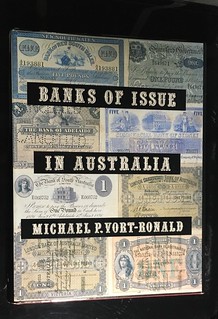
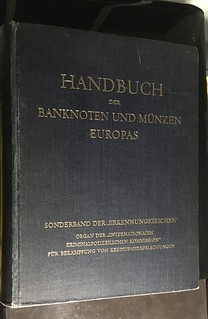
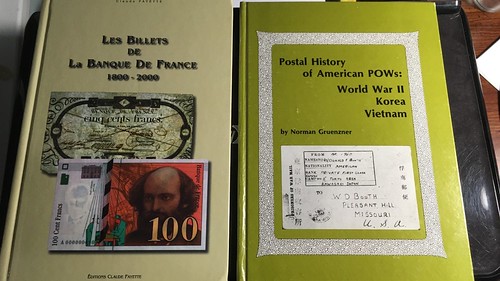
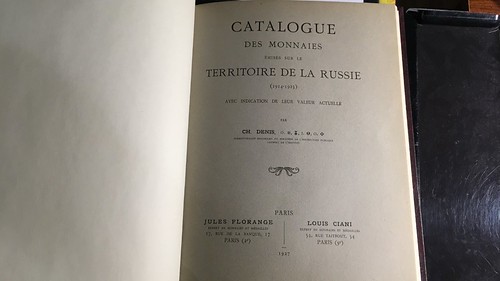
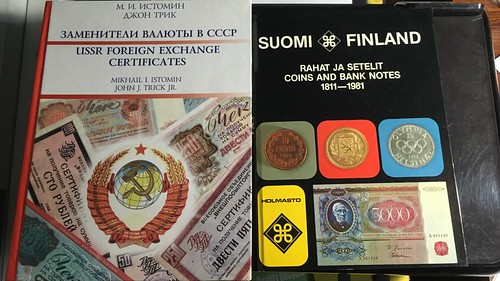
Mandar notes that prices are negotiable, particularly for multiple purchases. See his website for more information. This looks like a great opportunity for banknote collectors. -Editor
For more details, see:
http://rarepicks.net/numismatic-estate-library-books-for-sale
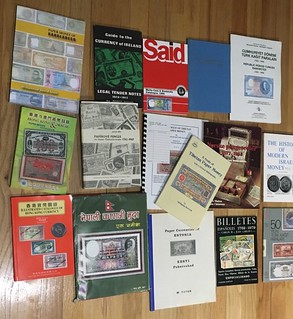
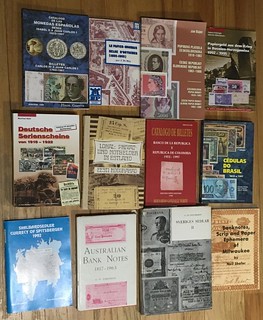

NEW BOOK: THE NUMISMATIC EDGAR ALLAN POE
Greg Ruby edits The Fourth Garrideb, a newsletter devoted to the numismatics of the Sherlock Holmes canon. He's published a new book on another literary topic, the numismatics of Edgar Allan Poe. Congratulations! Here's the announcement. -Editor
 I'm pleased to announce that The Numismatic Edgar Allan Poe, a project inspired by your readers' reactions to one of the first posts from The Fourth
Garrideb website that you were kind to share, is currently at the printers and will be available starting 1/20.
I'm pleased to announce that The Numismatic Edgar Allan Poe, a project inspired by your readers' reactions to one of the first posts from The Fourth
Garrideb website that you were kind to share, is currently at the printers and will be available starting 1/20.
The 160 pages feature over 50 numismatic items, plus sections for Hobo nickels, pathtags and other related items. In addition, we have included several related articles relating to Poe and numismatics.
Paperback version is $25 postpaid. Hardbound version is $50 postpaid, and quantity will be based on orders received by 2/1., with shipment shortly thereafter. The hardbound edition will also feature color photographs when available.
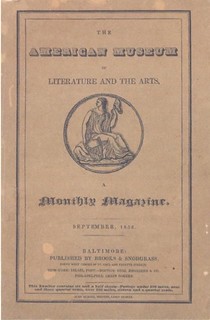
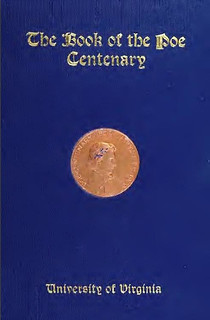
E-Sylum readers are awesome, and this isn't the first time their contributions have inspired an author - for example, Fred Reed's book Show Me the Money about stage currency and movie money came about after discussions of the topic. I'm glad we could help.
The book opens with five interesting chapters laying out the arc of Poe's life and work, as well as the history of his gravesite and markers funded by fans of the father of the detective novel genre. The Introduction to the Catalog lays out the book's identification scheme noting that gaps have been left for anticipated future discoveries. Books such as these are always works in progress that may never be fully done, but discovery is all part of what we enjoy about numismatics.
While price guides can also become quickly obsolete, they are at the top of the list of desired features in a catalog for many collectors and dealers. The book provides a price estimate range for each piece described, on a scale of ten levels ranging from under $10 to over $1,000.
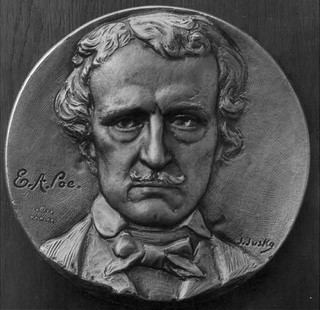 Bibliophiles will appreciate the entries for the Grolier Club Poe medallions and the University of Virginia Poe Centenary medal, which came housed in an accompanying
book. Coin dealer Thomas Elder also produced a nice medal in his "Medallions of the Immortals" series.
Bibliophiles will appreciate the entries for the Grolier Club Poe medallions and the University of Virginia Poe Centenary medal, which came housed in an accompanying
book. Coin dealer Thomas Elder also produced a nice medal in his "Medallions of the Immortals" series.
The range of Poe material is wide, spanning not just tokens and medals but also coins, badges, ingots and wooden money. I particularly liked the medals and commemorative and fantasy banknotes, many of which were quite well designed and executed. The book illustrates nearly every piece. Most are described in great detail and included are interesting diversions into related numismatic topics such as the under-construction second Mint of the United States and Poe's criticism of the 1849 gold dollar.
Contributors include NBS Historian Joel J. Orosz and Dr. Heinz Tschachler, author of the book The Monetary Imagination of Edgar Allan Poe - Banking, Currency and Politics in the Writings.
The Numismatic Edgar Allan Poe is far more than a straightforward catalog of items - it is quite readable and entertaining, holding quite a few tidbits of interesting numismatic information - ideal for the typical E-Sylum reader.
-Editor
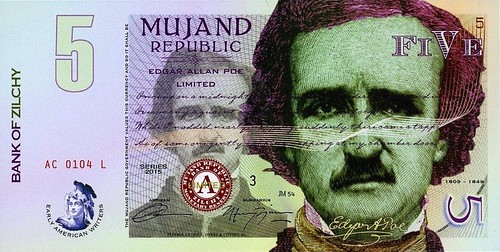
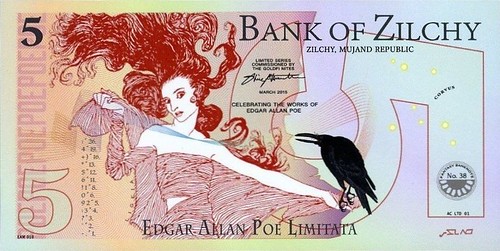
Mujand Republic 5 Zilchy Fantasy Banknote
For more information, or to order, see:
https://PoeCoinBook.com or
https://fourthgarrideb.com/shop/
To read the earlier E-Sylum articles, see:
NUMISMATIC REMEMBRANCES OF EDGAR ALLAN POE (https://www.coinbooks.org/esylum_v17n45a22.html)
MORE NUMISMATIC REMEMBRANCES OF EDGAR ALLAN POE (https://www.coinbooks.org/esylum_v17n46a10.html)
NOTES FROM E-SYLUM READERS: NOVEMBER 16, 2014 : Jeff Starck 's Article on Poe Medals
(https://www.coinbooks.org/esylum_v17n47a12.html)

NEW BOOK: THE COIN-WEIGHTS OF IRELAND
Paul and Bente Withers have published a new book on the coin weights of Ireland. Congratulations! -Editor
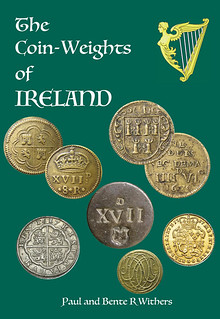 We are delighted to announce that Galata has produced a new book The Coin-Weights of Ireland. This is based on the Irish section of our original publication
BRITISH COIN-WEIGHTS - A Corpus of the Coin-Weights made for use in England, Scotland and Ireland. Published by Galata Print Limited, in December 1993. However, we had been
researching ten years before that and collecting coin-weights for another decade before that, so a new edition is definitely due.
We are delighted to announce that Galata has produced a new book The Coin-Weights of Ireland. This is based on the Irish section of our original publication
BRITISH COIN-WEIGHTS - A Corpus of the Coin-Weights made for use in England, Scotland and Ireland. Published by Galata Print Limited, in December 1993. However, we had been
researching ten years before that and collecting coin-weights for another decade before that, so a new edition is definitely due.
Coins, medals and tokens are often collected because they are miniature works of art, but in addition to that, the legends, inscriptions and portraits on coins of the ancient world give us information as diverse as rulers and their names, when they reigned, political and economic alliances of nations, contemporary fashions and hairstyles, architecture, mints, governmental and regional control, religion and more. Much the same holds true for medieval and modern coins.
Coin-weights, however, are slightly different, presenting challenges that coins do not. For example, there are several kinds. Basically there are those that tell us exactly what the coin should weigh, whilst others indicate a minimum weight, below which it was worth only its scrap value. A third type are used to measure by how much precious metal the coin was light.
In some ways coin-weights are less revelatory, but in others their collection and study can sometimes tell us more about national and international economies, and economics than the coins themselves. Irish coin-weights are really revealing in this respect in that they, and the proclamations legitimising them, are solely for foreign silver and gold coins, which at that time comprised nearly all of the circulating medium in Ireland, as no native silver or gold coins were struck in Ireland after the silver issues of James I, apart from the emergency issues such as the Inchiquin and Ormonde coinages struck during the Eleven Years' War that took place in Ireland in the 1640s and 1650s.
The most interesting are those termed ‘monetiform' coin-weights which have on them the design of the coin they were intended to weigh. The majority of the population of Europe, until just over a century ago were illiterate and innummerate, so to indicate which weights were to weigh which coins, most coin-weights were generally made to look like the coins.
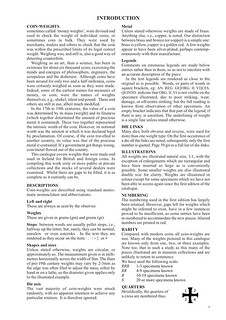
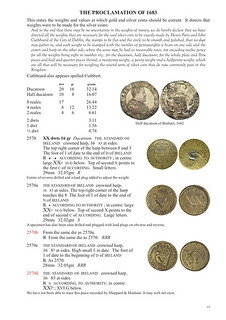
The first thing that readers will notice is that the cover and most of the illustrations are printed in high definition colour, something that would have been prohibitively expensive 26 years ago. Closer examination will reveal that recent improvements in technology have given us the ability to match the catalogue text more closely in size and font to the original item.
Observations of many hundreds more weights have meant that corrections have been possible. Many of the weights we recorded 40 years ago were known from a single example, and some of those were struck off-centre, thus we could not be sure of the legend. Many were weakly struck from worn dies, so we were also unsure of the punctuation. Some of the weights we now have listed have had their legends and punctuation confirmed from three or more specimens.
Then there were errors that were entirely our own fault – we had, in one instance, failed to observe that the legend did not read THE STANDARD OF IRELAND, but THE STANDARDARD OF IRELAND... How could the engraver make such a blunder, and we not notice it? Well, it was a worn weight and much of the legend was invisible due to off-centre striking, complicated by file marks due to the flan having been adjusted. There are also those mistakes that the use of computers cause. You copy a similar catalogue entry to make a new one, and paste it elsewhere into the document, the phone rings and whilst distracted, you forget to delete, or change that part of the legend you intended to alter. We have corrected several such errors. Many previously unlisted items (71) have turned up. Two items in particular deserve mention: the first is one which shows that weight production was not limited to Dublin and Cork, but extended also to Limerick; and that coin-weights made in Dublin, were countermarked by an Ulster seller.
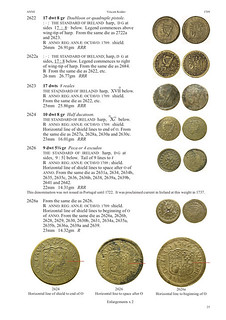
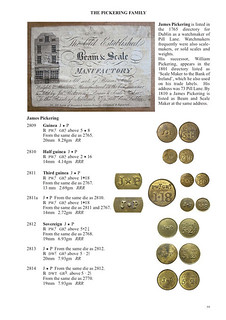
Three further decades of experience in numismatics, photography, typesetting and new technology have somewhat refined our techniques and abilities in using those technologies.
With all of these improvements, you might ask why some of the illustrations are still in black and white – the simple explanation is that the photos were taken 40 years ago, and whilst we still have the original b&w record photographs, many of the then owners of those weights have now, sadly, passed on, or we may have lost contact with them.
Undoubtedly, new previously unseen weights will turn up, and further improvements can be made in the future, but we hope that this edition will be the standard reference for many decades to come.
Paul & Bente Withers
bente@galata.co.uk
visit our website: www.galata.co.uk
Here are some of the details from the web site. -Editor
Nearly 400 items listed and illustrated. Rarity ratings. Many previously unpublished weights. Well illustrated, mostly in colour. Paperback, A4 (210 x 297mm) 68 pages.
Price: £25.00
For more information, or to order, see:
The Coin-Weights of Ireland
(http://www.galata.co.uk/store.asp?storeAction=showDetail&stockID=12315)

NUMISMATIQUE ASIATIQUE DECEMBER 2019 PUBLISHED
The Société de Numismatique Asiatique (The Asian Numismatic Society) has published the December 2019 issue of their journal. Here is the table of contents. -Editor
 EDITORIAL
EDITORIAL
Французско-русское нумизма
тическое сотрудничество
Collaboration numismatique franco-russe
CHINE
Russian assay marks on Chinese silver ingots
by Vladimir Belyaev
CAMBODGE
La date exacte inscrite sur l'avers du Tical d'Ang Duong et l'événement auquel elle se rapporte
par Olivier de Bernon
INDES
« Cash » ou « flouze » ? Le trésor de tokens de l'Admiral Gardner (Goodwin Sands, 1809)
par Nicolas Ducimetière
(Paris, Bibliothèque Nationale de France, 17 novembre 2018)
Numismatique de l'Indochine aux XIXe et XXe siècles
SECONDE PARTIE
Alain Escabasse :
Léon Ardouin (1841-1909), un numismate méconnu de l'Indochine
Daniel Cariou :
Piastre indochinoise et fluctuation du cours de l'argent
Cinquièmes Rencontres de Numismatique Asiatique
Sixièmes Rencontres de Numismatique Asiatique
Appel à communications
Nouvelles brèves
Sommaires des nos 1 à 32 de Numismatique Asiatique
Série « Monnaies d'Asie »
For more information, see:
The Société de Numismatique Asiatique
(https://sites.google.com/site/societedenumismatiqueasiatique/home)
BOOK REVIEW: A NUMISMATIC HISTORY OF ECUADOR
As part of his ECUADORIAN COINS - LIST #56, dealer Dale Seppa included this review of the 2001 book by Michael Anderson, A Numismatic History of Ecuador. We're republishing it here with permission. Thanks. -Editor
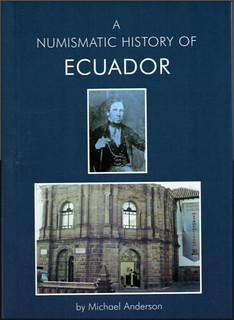 A NUMISMATIC HISTORY OF ECUADOR
A NUMISMATIC HISTORY OF ECUADOR
by Michael Anderson, Greenlight Publishing (UK) & Latin American Press, 2001, illustrated, softbound with color illustrations on cover, 394 pages including comprehensive index
and appendices. Available from: Dale Seppa, 103 N 6th Avenue, Virginia, MN 55792 for US$50.00 postpaid for shipment to U.S. addresses. Foreign orders please add US$25.00 for
additional postage.
It is worth noting that an article published by David B. Fiero Ph.D., in World Coin News awhile back, is a truly excellent synthesis of the book, to include not only minting and monetary considerations, but also the economic, political and social implications for the pre-republican and early republican period in Ecuador. Fiero, one of only a very few in the United States with a doctorate in numismatics, wrote an outstanding essay that synthesizes the two hundred years of Ecuadorian numismatic history, covered in this book, in less than a dozen pages. That review was entitled; EYES WIDE OPEN, EARS WIDE SHUT: Ecuador's Struggle in the Nineteenth Century. Responsible "Minthood" or Quixotic "Enchantment"? Based on a pre-publication copy of the book, and his extensive knowledge, he more than adequately comments about the book, the mint, the country, the circumstances and the individuals involved.
That said, I will give a very brief summary of what Anderson covers in A NUMISMATIC HISTORY OF ECUADOR.
Starting with a brief Michener-like view of early Ecuador which also covers the various items used as a "store of wealth", Anderson proceeds to a brief yet detailed synthesis of colonial monetary affairs in the Royal Audiencia of Quito to include its interdependence on the Viceroyalties of Peru and New Granada. The footnotes by themselves often give information that modify widely accepted views; for example #32 on page 8: "Arnaldo J. Cunietti-Ferrando, Bischoff, op. cit., says... that the assayer Antonio Ovando was invented by Bartolome Arzans de Orsua y Vela in his HISTORIA DE LA VILLA IMPERIAL DE POTOSI and that the name is not confirmed by contemporary documents. Nevertheless, the name is quoted twice in the Cabildo of 30 December 1652 and three times in that of 12 June 1657."
The Quito mint produced coinage from 1832 until 1863, yet was an incongruous institution meant for another time and place. Although the coinage was accepted throughout Ecuador and indeed throughout the world, it was essentially a local coinage, with the majority of the coins circulating in and around the remote city of Quito. The overall history of the mint can be conveyed in 3 words - "lack of funds".
Throughout its 30 year life, the mint suffered from obsolete equipment which was often in a state of disrepair. The original machinery was scavenged from some unknown pre-republic source, in accordance with a Boliviarian decree of 1823, and spent many years in the house of a Colonel Klinger, who used it for "his own purposes", until he was forced to give part of it back to start the mint. The first acquisition of relatively modern equipment, other than a "new" coining press which might have arrived in early 1834 and a few odd items sporadically acquired, came when Guillermo Jameson was able to acquire some equipment confiscated from counterfeiters in Manabi in 1848.
Ecuador had no mountain of silver nor any significant source of gold. Some of its first coins were struck with contributions from a few concerned citizens. The very first circulating coins were struck with silver "donated" by the churches. From that ignominious start, the mint limped along with silver and sometimes gold, imported at high cost or secured from small miners by charging them the equivalent of the Royal Fifth (20%) in return for minting their bullion. This actually constituted a barter system as opposed to a cash purchase system.
That coins were produced at all, is a tribute to many; doctors, soldiers, a lady engraver and many humble, workingmen. The mint personnel were generally untrained, virtually bereft of financial support, and without proper machinery or materials. Regardless of difficulties, lack of experience, lack of support, lack even of a proper building, they struck beautiful, lasting coinage of the stated fineness, recognized throughout the world.
There were problems in addition to those of production. Pre-decimal Ecuador was inundated with counterfeits. During many periods they were so ubiquitous that the government gave up the fight and allowed the counterfeits to circulate, with no penalty for the counterfeiters, even though the official penalty was death. The frequent schemes to confiscate and destroy counterfeits were usually halted, as soon it was realized that if all counterfeits were destroyed there would not be enough coinage for the people's daily necessities.
Most counterfeits were eventually destroyed and the legitimate (as well as some of the better counterfeit) pre- decimal coins were not only used, but abused, for decades after issue, with none of them ever being retired for any reason, unless holed or if no vestige of the design remained. Over 90% of the small issues were worn blank and then used as bullion. In 1880 one foreigner turned in English banknotes for Ecuadorian coins and was not able to identify any of the coins because of excessive wear; he additionally reported that his change for purchases in stores, was often given to him in bread or eggs because there were no small coins available.
About 225 pages of the total of some 400 pages covers the period mentioned above, as this is the most interesting period of Ecuadorian numismatic history.
The balance of the book is devoted to the remaining periods up to the "dollarization" of the Sucre and includes the following chapters; Towards a Copper Coinage; The Introduction of the Sucre; The First Gold Standard; The Moratory Law; The Kemmerer Mission and the Second Gold Standard; From the Coinage Laws of 1937 to the Dollarization of the Sucre, as well as fifteen appendices, the extensive bibliography and a very detailed index. It is perhaps worth noting that the Ecuadorian "dollarized" coins of the year 2000 are illustrated as some numismatic publications have stated that there are no Ecuadorian coins dated later than 1997.
While banknotes are not covered extensively, certain interesting facts emerge such as; "The issued specimen of Pick S111 dated 1 October 1868, described in Pick as `reported not confirmed', is illustrated by Estrada. It is signed by Clodoveo Cortes, and is in fact a provisional issue by the Banco del Ecuador before its own notes were printed."
The book is extremely valuable for the serious historical researcher as well as the numismatist as dozens of documents have been translated to English, to include the regulations of the mint and most of the mint reports from 1836 through 1857, as well as actual correspondence from and to William Jameson, the Chief Assayer and later Director of the Mint.
Anderson is a serious author and researcher with Bachelor's and Master's degrees from Cambridge University. He has been interested in coins from a very early age and has served on the Council of the British Numismatic Society and has been Secretary and President of the London Numismatic Club and Treasurer of the British Association of Numismatic Societies. He has contributed dozens of articles to the numismatic press, from "The Coins of the Grand Princes of Kiev" in Seaby's Coin and Medal Bulletin in 1963 to his last published article "Aristobulos of Chalcis and Salome" in Coins & Antiquities of April 1999. He joined the British Foreign and Colonial Office in 1958 and served as British Vice-Consul in Ecuador from 1965 to 1968, whence his interest in the coinage of Ecuador. He co-authored the second edition of "The Coins of Ecuador", published by Almanzar's Coins of the World in 1973. His own extensive collection of Ecuadorian coins, sold by Glendinings in February of 1977, is generally recognized as one of the most important reference works for the serious collector of Ecuadorian coins.
Dale can be reached at daleseppa@gmail.com . -Editor
For more information, or to order, see:
NUMISMATIC HISTORY OF ECUADOR by Michael J. Anderson
(https://www.ebay.com/itm/NUMISMATIC-HISTORY-OF-ECUADOR-by-Michael-J-Anderson/163987890643)
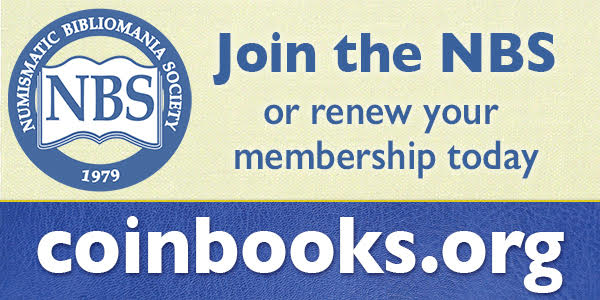
GENE GARDNER REMEMBERED ON THE NEWMAN PORTAL
The latest addition to the Newman Numismatic Portal is a video about collector Gene Gardner. Project Coordinator Len Augsburger provided the following report. -Editor
Legendary Coin Collector Gene Gardner Remembered
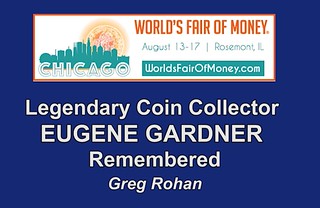 At the August 2019 World's Fair of Money in Rosemont, IL, Greg Rohan of Heritage Auctions spoke to the Liberty Seated Collectors Club about the life and collecting
career of Gene Gardner (1936-2016). The summer ANA convention is a busy event with attendees deciding on the fly which meetings to attend amidst a flurry of commercial activity.
Jewels are often missed, and Rohan's presentation, while well attended, will be of interest to a wider audience.
At the August 2019 World's Fair of Money in Rosemont, IL, Greg Rohan of Heritage Auctions spoke to the Liberty Seated Collectors Club about the life and collecting
career of Gene Gardner (1936-2016). The summer ANA convention is a busy event with attendees deciding on the fly which meetings to attend amidst a flurry of commercial activity.
Jewels are often missed, and Rohan's presentation, while well attended, will be of interest to a wider audience.
Rohan recounted Gene's early days in the hobby, which culminated with a significant consignment to Stack's in 1965. Thereafter Gardner concentrated on family and business, and was reintroduced to the hobby many years later, upon attending one of the Eliasberg sales. Gardner resumed collecting full throttle and eventually sold his collection in a group of four sales conducted by Heritage Auctions in 2014-2015. Rohan talks about the dispersal of the collection and shares many personal recollections about Gardner – this is a truly moving presentation that poignantly reminds us about the human side of the coin business. Newman Portal acknowledges David Lisot for making this video available on NNP.
Link to Greg Rohan's presentation, Legendary Coin Collector Gene Gardner Remembered on Newman Portal:
https://nnp.wustl.edu/library/book/573122
Link to Stack's February 1965 sale of the Gardner collection:
https://nnp.wustl.edu/library/auctionlots?AucCoId=3&AuctionId=516419
VIDEO: LIBERTY SEATED COIN CLUB LEADERSHIP
These are selections from the David Lisot Video Library that feature news and personalities from the world of coin collecting. David has been attending coin conventions since
1972 and began videotaping in 1985. The Newman Numismatic Portal now lists all David's videos on their website at:
https://nnp.wustl.edu/library/multimediadetail/522852
Here's one on leadership changes at the Liberty Seated Coin Club. -Editor
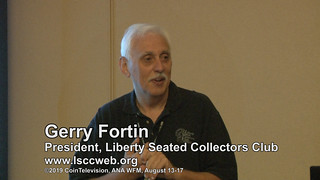 Liberty Seated Coin Club Gets New Leadership.
Liberty Seated Coin Club Gets New Leadership.
An excerpt of the video is available for viewing on the Coin Television YouTube Channel at:
https://youtu.be/lwwPpXMA5W0
Gerry Fortin, President, Liberty Seated Collectors Club, David Lisot, Video Producer, CoinTelevision.
Gerry Fortin retires and nominates Len Augsburger as LSCC President. Gerry has spent years in his role as president of the Liberty Seated Coin Collectors Club. Now he decided to retire. He shares his thoughts about leadership and nominates Len Augsburger for president and Dennis Fortier for vice-president as the next generation of leadership.
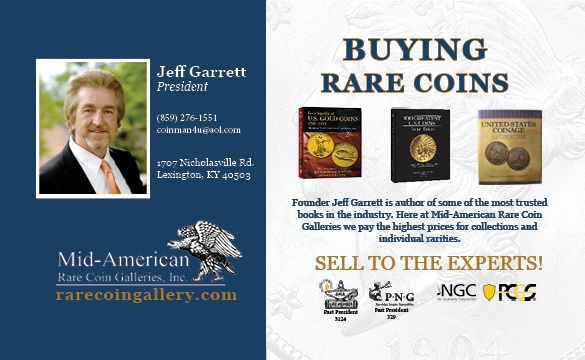
DUBLIN COIN ARTIST PJ LYNCH
Arthur Shippee passed along this BBC News article about Dublin coin artist PJ Lynch. Thanks! -Editor
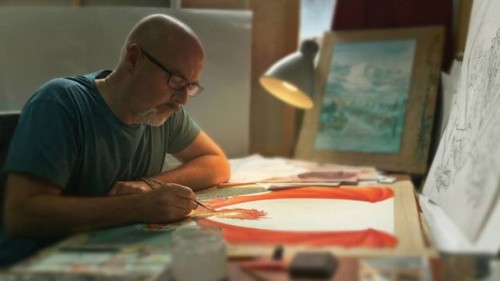
An award-winning illustrator from Northern Ireland is behind a new coin to mark the Chinese Year of the Rat.
PJ Lynch who was born in Belfast and lives in Dublin designed the coin featuring a rat with a set of long twitchy whiskers.
Lynch is famous for his children's books and has served as Laureate na nÓg - or all-Ireland children's laureate.
He has won Kate Greenaway medals, the Mother Goose Award and the Christopher Medal.
PJ Lynch said he felt "very honoured" and "very lucky" to have been asked to design what is the latest coin in the Royal Mint's Shengxiào Collection.
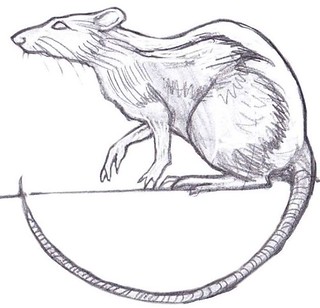 "When I was invited to submit a design, I thought I'm not mad about rats and rodents generally scare the life out of me," he said.
"When I was invited to submit a design, I thought I'm not mad about rats and rodents generally scare the life out of me," he said.
"But I did a lot of research and met a lot of people who are mad about rats and learned about how intelligent they are and the qualities they have.
"It made me look afresh and I made lots of drawings."
PJ Lynch has created everything from posters for Opera Ireland and the Abbey Theatre in Dublin to several sets of Irish stamps.
He also designed a giant mosaic for the Catholic Marian Shrine in Knock, County Mayo.
He lives in Dublin with his wife and three children.
The Year of the Rat starts on 25 January and is the first sign of the Chinese Zodiac.
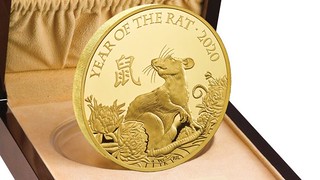 While intelligence and optimism are said to be traits of those who share the sign, they may also have deep pockets.
While intelligence and optimism are said to be traits of those who share the sign, they may also have deep pockets.
The five ounce gold version of the coin is now fully reserved, despite costing £9,995.
But there are other coins available ranging from about £2,000 to just £13.
To read the complete article, see:
Belfast artist PJ Lynch designs Chinese New Year coin
(https://www.bbc.com/news/uk-northern-ireland-50971500)
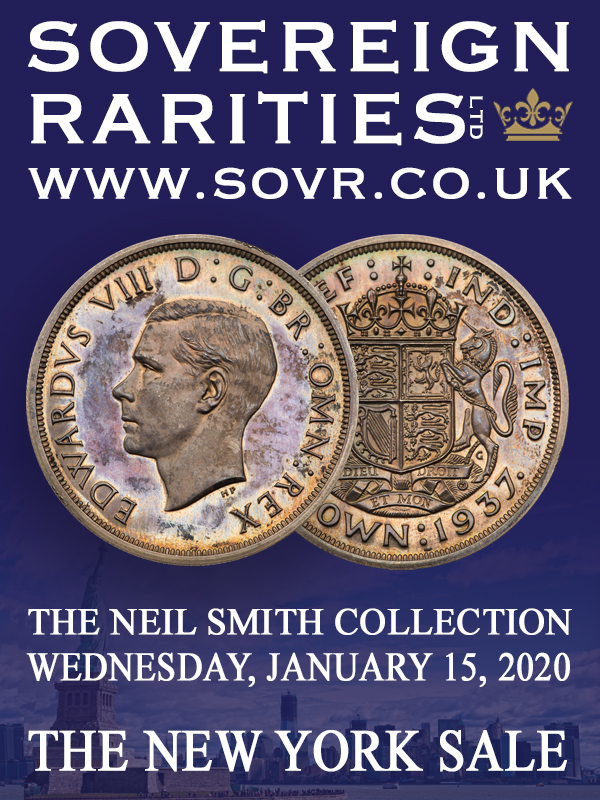
MORE ON JOSEPH SEGEL AND THE FRANKLIN MINT
Coin Dealer Opinion on The Franklin Mint
Scott Semans writes:
Your excerpt from the Philadelphia Inquirer obit on native son Joseph Segel, creator of the Franklin Mint, was expectably complimentary. Collectors and dealers, on the other hand, might not speak so well of the dead. It is perhaps still an open question where the balance lies, between attracting new collectors with heavily promoted manufactured rarities, and driving them away when the aftermarket reveals their inherent worthlessness. Dealers in particular have no reason to love the Franklin Mint, which for decades diverted collector dollars away from legitimate numismatic items and other collectibles with actual historical value. I was pleased to find your link to a more balanced view with juicy details on FM's early and middle periods: David Alexander's lively article in CoinWeek, "The Rise and Fall of the Franklin Mint."
Funnily enough, dealers today level the same criticisms at the U.S. Mint. Not without justification, of course - both Mints overpromote, overprice and oversell many of their products, leaving little upside for the original purchasers and mostly headaches for the aftermarket. Yet price aside, many of the products (not all, of course) are well-designed and well-made, and some may well end up as favorites of future collectors.
Both mints create and supply talent - quite a few top sculptor-engravers have both the Franklin and U.S. Mints on their resume. And the numismatic community did gain at least one lasting benefit - funding that enabled the Token and Medal Society to publish Bob Julian's landmark book on the medals of the U.S. Mint. Segel likely made other donations to numismatic organizations that I'm not aware of. But as Scott noted, the Franklin Mint's primary legacy today is one of taking dollars out of the overall numismatic market. It will be interesting to see whether this view becomes more nuanced as more years pass. Do any of our readers actively collect or deal in Franklin Mint items? -Editor
Franklin Mint's Initial Public Offering
David Thomason Alexander submitted these notes on the early days of the Franklin Mint and the listing of its stock. Thanks. -Editor
I read with deep interest the laudatory obituary of the late Joe Segel. Whole books could be written on the meteoric rise and ultimate fall of General Numismatics Corp., (GNC) later known as the Franklin Mint and vigorous controversy would necessarily be a part of such a complete history. One factual correction is needed, however. GNC stock was first listed not on the New York Stock Exchange, but on the little known National Stock Exchange, then a distant number three in the roster of American securities exchanges. I know of this because my late brother, John L. Alexander (1938-1987) was instrumental in arranging the floating of the first stock through the securities firm of Hill, Darlington and Grimm, who were then very active in Promoting new stock issues.
Segel's first major product was gaming tokens for casinos in Nevada and elsewhere who were seriously impacted by the disappearance of silver dollars from the banks. Base metal tokens to take their place brought Segel a total of $272,000 in the first year of reporting. John and I spent several days scrounging up examples of these tokens for Hill, Darlington and Grimm executives to examine. There was later a finely designed Franklin Mint token celebrating the new stock listing. Money realized from this first stock issue was used to assure Segel of a reasonably priced silver bullion supply just before the precious metals boom that was soon raging.
The GNC name was soon retired and the Franklin Mint under later management was enveloped in controversy - remember Morley Safer and "Sixty Minutes..." The company was never a strictly numismatic phenomenon but a spectacular example of the success of American advertising and promotion. At the beginning many numismatic "names" were associated with the firm, none as closely as the late one-time ANA president Virginia Culver and numismatic writer-editor Russ Rulau. Virginia's name graced the catalogue of Franklin Mint material once published by Krause; Rulau never ceased to defend the Franklin Mint through his defense of Virginia...
So much more could be written.
Here is the listing for the GNC National Stock Exchange listing medal from the 1969 edition of Numismatic Issues of the Franklin Mint. -Editor
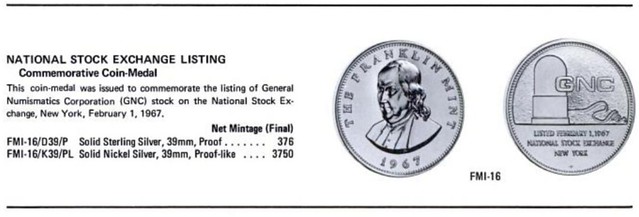
Franklin Mint Casino Tokens
David Lange submitted these notes on the Franklin Mint casino token albums. Thanks. -Editor
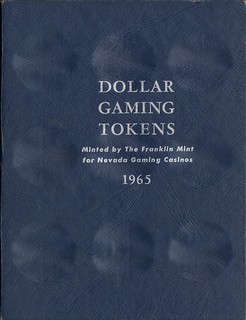 I saw the obituary of Joseph Segel. Though I never met the man, I've read a lot about him with respect to his numismatic enterprises. One of these was a
custom-printed Whitman blue folder to house Franklin Mint's output of casino tokens dated 1965.
I saw the obituary of Joseph Segel. Though I never met the man, I've read a lot about him with respect to his numismatic enterprises. One of these was a
custom-printed Whitman blue folder to house Franklin Mint's output of casino tokens dated 1965.
When casino customers began taking home their silver dollars instead of cashing them in before leaving, the coins soon disappeared from gambling tables and slot machines. Casino owners commissioned nickel-alloy tokens of dollar size to replace them. These served their purpose well, but they also became collectibles to some degree. In 1965 Segel contracted with a consortium of Nevada casinos to produce their tokens, and he also sought to market them directly to collectors.
His folder for the 1965 tokens is shown in the attached photos. The following year he dropped Whitman in favor of Dansco, which produced two actual albums with clear slides for the 1966 series. I have these albums, too, but I haven't gotten around to taking images. This awaits completion of Volume Three in my series of books about album/folder publishers, which covers Whitman products. Volume Four will be a treatment of Dansco's various lines.
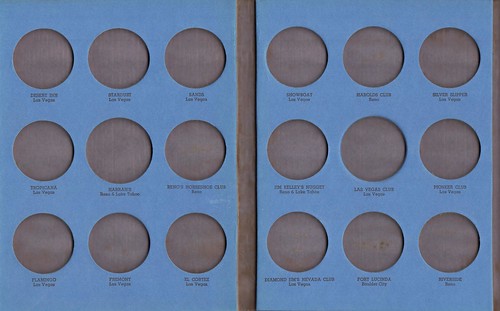
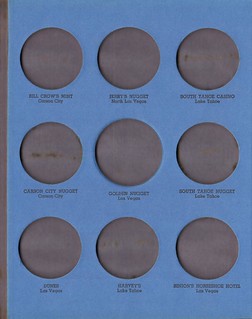
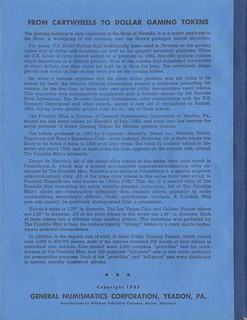
Dave adds:
Another interesting aspect of the casino tokens is their edge pattern of alternating plain and reeded segments, uniquely signifying each individual casino. The Franklin Mint was granted a patent for their system in 1967.
See also the Wall Street Journal article (provided by David Sundman) and the CoinWeek article, which includes a note from retired U.S. Mint engraver Don Everhart, who previously worked for the Franklin Mint. Both are linked below.
And elsewhere in this issue see excerpts from Lou Golino's excellent piece for Coin Update on the Franklin Mint's legacy for modern numismatics. -Editor
To read the complete articles, see:
Joseph Segel Made QVC a Hit, With Help From a Dancing Gorilla
(https://www.wsj.com/articles/joseph-segel-made-qvc-a-hit-with-help-from-a-dancing-gorilla-11577383496)
Franklin Mint, QVC Founder Joseph M. Segel: In Memoriam
(https://coinweek.com/people-in-the-news/franklin-mint-qvc-founder-joseph-m-segel-in-memoriam/)
To read the earlier E-Sylum article, see:
JOSEPH M. SEGEL (1931-2019) (https://www.coinbooks.org/v22/esylum_v22n52a03.html)
THE BOOK BAZARRE
NOTES FROM E-SYLUM READERS: JANUARY 5, 2020
Washington's Dollar Sign Located
Regarding the 1792 George Washington bond illustrated last week, I asked, "... where exactly is the dollar sign the caption refers to? The bond is hard to read because writing on the back is bleeding through. " -Editor
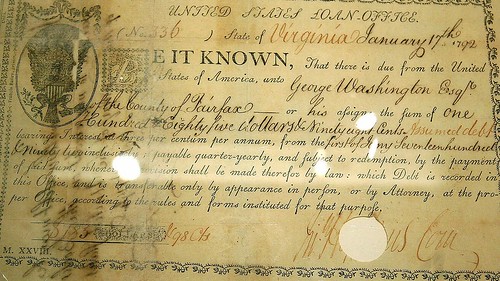
Don Cleveland writes:
Washington's dollar sign is at the lower left of the document, just above the III of M.XXVIII.
Bill Eckberg also spotted the dollar sign, and helpfully circled it. Martin Purdy of New Zealand also located it. Thanks, everyone. -Editor
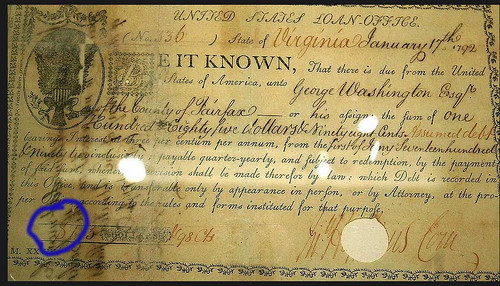
To read the earlier E-Sylum article, see:
BBC ON THE ORIGINS OF THE DOLLAR SIGN (https://www.coinbooks.org/v22/esylum_v22n52a27.html)
Careful With That Stapler!
Alan Weinberg writes:
"Relative to stapling or removing coins from stapled 2x2s: I am reminded of the story of how legendary collector Harry Bass once put a staple into a Proof-only 1863 gold quarter eagle."
Ouch! -Editor
To read the earlier E-Sylum article, see:
UNINTENTIONAL WAYS COLLECTORS DAMAGE COINS (https://www.coinbooks.org/v22/esylum_v22n52a12.html)
Saint Wulfric
Regarding the British Museum's newly-acquired Wulfric seal, Jim Duncan of New Zealand writes:
"There are numerous entries in Wikipedia for a Wulfric who became a saint. So I guess the seal is not his only mark. An heraldic whiz might be able to locate his arms...!"
To read the earlier E-Sylum article, see:
BRITISH MUSEUM ACQUIRES 1,000-YEAR-OLD SEAL (https://www.coinbooks.org/v22/esylum_v22n52a26.html)
The Deep Detail of Linotypy
Joseph Alan Barnosky writes:
Three cheers for Harvey Stack's use of the term "leadering".
So much time have I into the brain-racking of gregarious insecurity. Often enough the clue to turning off an unintended tangent is found in the homophony of something, either English or foreign, but of what?
Can't stop remembering your Canadian friend who really pronounced the "T" as "T" that time? Since when am I interested on the deep detail of linotypy?
Ah. The homophony of what!
To read the earlier E-Sylum article, see:
NOTES FROM E-SYLUM READERS: DECEMBER 29, 2019 : Harvey Stack on Printing Technology
(https://www.coinbooks.org/v22/esylum_v22n52a06.html)

MORE ON THE CENTRAL AMERICAN UNION PACT
Brian Stickney writes:
Reference your recent comment that you would like to have more information regarding the 1890 gold Guatemalan medal for the Pact of Union - the below comments are drawn from: A Monetary History of Central America.
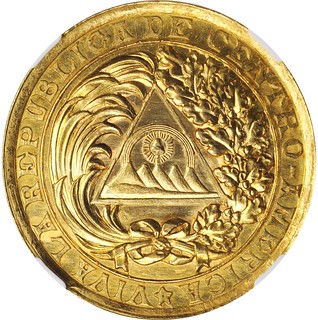
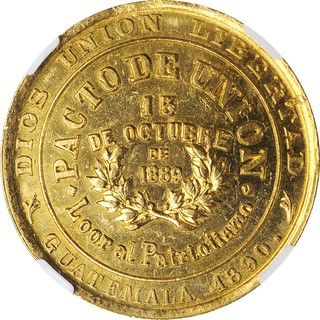
"The political origins of the medal date back to as early as 1871 when liberal, revolutionary forces under the command of generals Miguel Granados and Justo Rufino Barrios overthrew conservative forces which had been in power for 30 years. Granados assumed the presidency, renouncing that office in June, 1873, allowing Barrios to follow in his footsteps. Barrios became one of Guatemala's more charismatic leaders of the nineteenth century, retaining power until his death in 1885.
"Politically speaking, Barrios harbored delusions of grandeur, promoting the proposition that the Central American Federation (1825-1838) should be restored under his leadership, incorporating the states of Costa Rica, El Salvador, Guatemala, Honduras, and Nicaragua. Failing to convince others by diplomatic means, Barrios announced the restoration of the Federation on February 28, 1885, declaring himself the commander of the "united" army. The other countries failed to accept the proposition, even lobbying Mexico to intervene in the event of hostilities. As it turns out, intervention was unnecessary. Barrios invaded El Salvador but was killed at the battle of Chalchupa, April 2nd, thus, eliminating the military threat to force a union.
"The political will to unite Central America remained in some quarters, however. But Barrios' successor, General Manuel Barillas, (1885-1892) chose to pursue the concept of union through diplomatic means. A Pact of Union was successfully concluded October 15, 1889, commemorated by the striking of the gold medal at the mint in Guatemala. Copper and silver issues also are reported. In hopeful anticipation of union, pattern one and two centavo coins also were struck in copper, probably in Europe. In the end, all was for naught, as the Pact failed to be ratified by all five countries then making up Central America. "
Thanks! Sometimes things that don't happen are more interesting than things that do. It's nice to have these numismatic reminders. Brian also provided these images of the pattern coins; originally from Almanzar's Coins of the World, republished in the book A Monetary History of Central America, by the American Numismatic Society. -Editor
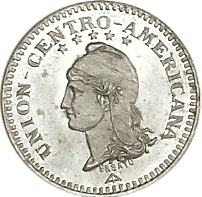
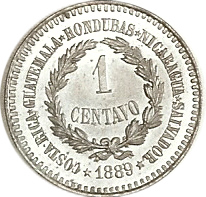
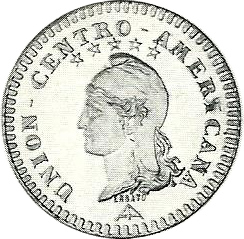
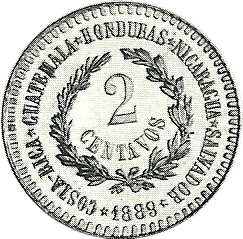
To read the earlier E-Sylum article, see:
: 1890 Central American Union Pact Gold Medal (https://www.coinbooks.org/v22/esylum_v22n52a17.html)
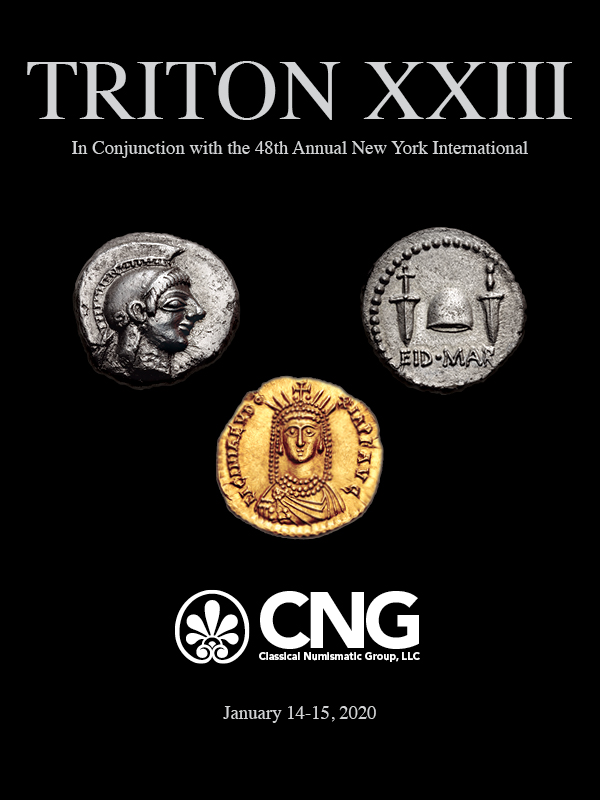
1902 PARIS IN LONDON EXHIBITION MEDAL AWARDEE
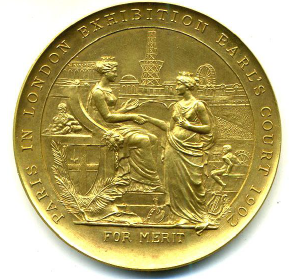
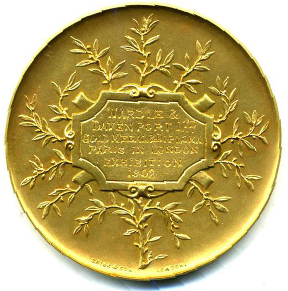
Jenna Moore Fuller writes:
I recently came upon your fascinating query / article regarding the 1902 Paris in London Exhibition medal. I'm an author who explores and writes about synchronicity, and my current work in progress involves several antiques, one of which bears a foil coin of this medal. Almost. It's an Excelda handkerchief box with contents, with a wonderful cover image that called to me. On one end of the lid is a sticker with the two sides of the gold medal like that shown in your query, minus the word "Paris". The background sticker reads "London Exhibitions 1902 & 1908 Awards for Excelda Hdkfs."
I realize that this isn't exactly the same as the one you pictured, but thought it might be of interest nonetheless, being related, though in paper form. Interestingly, Excelda also manufactured silk and cotton thread items like the medal awardee Wardle & Davenport of the query image.
I am finding quite a bit of info on the handkerchief company, but the medal remains quite a puzzle.
I am a bibliophile as well, collecting odd old books and hand-illustrated philatelic covers, and look forward to exploring the Numismatic Bibliomania site as well!
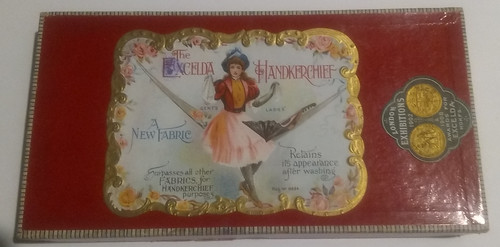
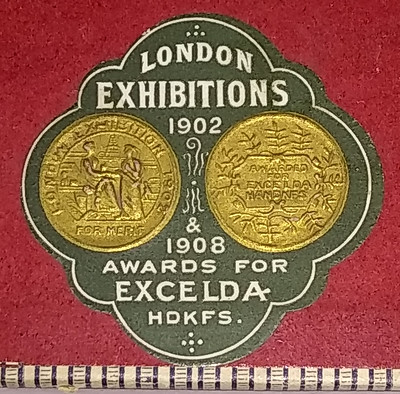
Thanks! Interesting. The exhibition prize medals became great marketing tools for the winning companies, who plastered images of them all over their products and advertisements.
Jenna also found the below advertising card featuring an image of the medal. Per her request I put her in touch with Joe Levine of Presidential Coin & Antique Company and Kenneth Traub, author of the original article. She can be reached at: jennamoorefullerbooks@gmail.com . -Editor
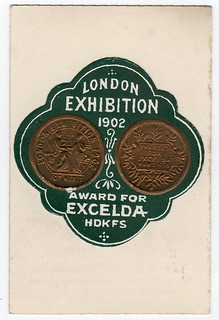
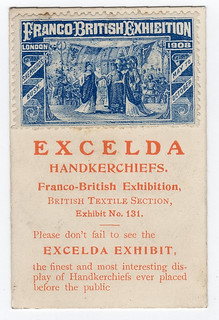
To read the earlier E-Sylum articles, see:
QUERY: 1902 PARIS IN LONDON EXHIBITION MEDAL UNIQUE? (https://www.coinbooks.org/esylum_v15n54a13.html)
MORE ON THE 1902 PARIS IN LONDON EXHIBITION MEDAL (https://www.coinbooks.org/esylum_v16n01a15.html)

THE FIRST KNOWN USE OF THE WORD 'NUMISMATICS'?
Gawain O'Connor writes:
My wife gave me as Christmas reading: The Word Detective, Searching for the Meaning of It All at the Oxford English Dictionary, A Memoir by John Simpson. Although this book is now a few years old, I don't think anyone has yet commented on its passage about the transition to the online world:
"Scholars – or just ordinary members of the public – could mail us with even newer and better evidence that they had managed to squeeze out of their memories or their databases. And they did. No sooner had we announced to the world that the earliest record of the word numismatics dated from 1803 than we were informed that it also had occurred in 1790 – as we hadn't thought to check in Adolf Ristell's Characters and Anecdotes of the Court of Sweden of that year. But this didn't annoy us – it was what was supposed to happen."
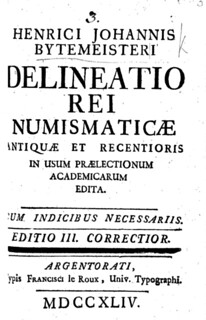 For grins I used the Google Books Ngram Viewer to chart the history of the word as seen in the books digitized and indexed by Google. I expected to find a number of
earlier examples. For 'numismatics' the results start about 1798, so no counterexample there. But dropping the "s" for the singular form pushes the first
occurrence back much farther, which is what I expected. Looking at the actual books I found that the first legitimate instance it found was Delineatio rei numismaticæ from
1744. That's not exactly 'numismatic' or 'numismatics' either, so there are many ways of defining the question and interpreting the answer. But numismatics was
a topic in print far earlier than 1744. I believe the first book on the topic was De Asse et Partibus (1514) by Guillaume Budé. But when exactly was the first use of the
term 'numismatic' in any of its forms? -Editor
For grins I used the Google Books Ngram Viewer to chart the history of the word as seen in the books digitized and indexed by Google. I expected to find a number of
earlier examples. For 'numismatics' the results start about 1798, so no counterexample there. But dropping the "s" for the singular form pushes the first
occurrence back much farther, which is what I expected. Looking at the actual books I found that the first legitimate instance it found was Delineatio rei numismaticæ from
1744. That's not exactly 'numismatic' or 'numismatics' either, so there are many ways of defining the question and interpreting the answer. But numismatics was
a topic in print far earlier than 1744. I believe the first book on the topic was De Asse et Partibus (1514) by Guillaume Budé. But when exactly was the first use of the
term 'numismatic' in any of its forms? -Editor
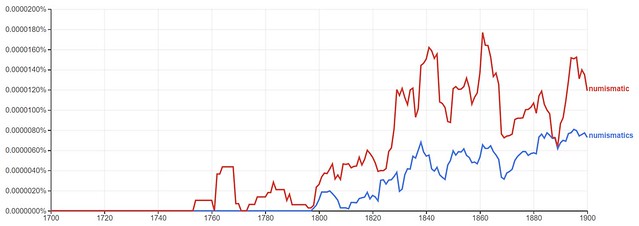
Even George Kolbe was stumped on this. He writes:
A fun topic. I have never thought about the etymology. Given its Latin roots, I am guessing the earliest use of the term goes way back.
Gawain adds:
I knew someone would have an earlier example - I guessed perhaps someone on your list would have been the one to give the example to the OED. I forgot to mention that the book was about the earliest use in the English language - not surprised there would be earlier Latin.
Agreed - an interesting topic. What do readers think? How could we best define the question? What answers await? -Editor

VOCABULARY TERMS: HIGH POINT, HIGH RELIEF
Dick Johnson submitted these entries from his Encyclopedia of Coin and Medal Terminology. Thanks. -Editor
High Point. The point of highest relief on a numismatic or medallic item. The high point – often the nose on a portrait – is formed from the lowest point of the die cavity. Examining the high point in the press room during striking is necessary for both medals and coins; it is the critical point which determines whether a medal is fully struck up in multiple striking, or for a coin during set up. High points are examined in the finishing department as well; as medals are oxidized and relieved they are examined to insure the high point is not overly buffed.
High points are the first to wear and the most vulnerable to damage, thus they are an important factor of condition. A collector or numismatist will check first an item's high points to determine wear or condition. If high points are particularly worn they are sometimes designated contact marks.
Also there are special high points – called support points. These are usually three in number, usually located on the reverse and sometimes hidden in the design purposely by the designer. Support points, as expected, support the item as it rests on a flat surface and somewhat prevents wear to the remainder of the design.
High Relief. Design projecting strongly from the background. Technically, high relief is a form of relief sculpture that is more than half projected from its background, with extensive undercutting. As such, the term would have no relationship to numismatics since this form of relief cannot be rendered into anything numismatic (and obviously cannot be made into or from a die).
However, the term is widely used in numismatic sales literature for multiple struck art medals with abnormal high design. An example is the Edgar Allan Poe Medal in the Hall of Fame for Great American series, 1963, by Michael Lantz. What is really meant here is high bas-relief (literally, high low relief – which does not mean medium relief – but instead, the highest possible form of low relief). Wherever the term high relief is found in numismatics this concept should be understood, rather than the form of sculptural relief with extensive undercutting that is standard in the art field. The term haute-relief is French for high relief. See relief.
Looking for the meaning of a numismatic word, or the description of a term? Try the Newman Numismatic Portal's Numismatic Dictionary at: https://nnp.wustl.edu/library/dictionary
Or if you would like a printed copy of the complete Encyclopedia, it is available. There are 1,854 terms, on 678 pages, in The Encyclopedia of Coin and Medal Technology. Even running two a week would require more than 19 years to publish them all. If you would like an advance draft of this vital reference work it may be obtained from the author for your check of $50 sent postpaid. Dick Johnson, 139 Thompson Drive, Torrington, CT 06790.

EMMETT T. JOHNSON (1836-1907)
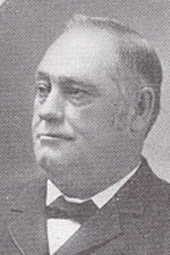 Emmett T. Johnson (1836-1907), was born in Fort Edward, New York. He lived with his brother Frederick Avery Johnson (1833-1893), at Glens Fall, New York. They both
graduated Glens Falls Academy. These brothers engaged in banking and the wool industry at Glens Falls, New York. Frederick went on to be elected to the U. S. Congress,
1885-1887.
Emmett T. Johnson (1836-1907), was born in Fort Edward, New York. He lived with his brother Frederick Avery Johnson (1833-1893), at Glens Fall, New York. They both
graduated Glens Falls Academy. These brothers engaged in banking and the wool industry at Glens Falls, New York. Frederick went on to be elected to the U. S. Congress,
1885-1887.
Emmett served as the Cashier of the First National Bank, Glens Fall, New York for forty-two years.
Emmett played a role in evaluating the circulation of the United States Trade Dollars in commerce and in banking. He considered them a burden and deficit and advocated getting them out of circulation rendering them defunct.
 In 1887, James Collins Hallock published his study on the problems of trade dollars in commerce and banking in his book, Repudiation of the Trade Dollars: The
Views of 300 Banks (1887) : 28, (not listed in Elvira E. Clain-Stefanelli)
In 1887, James Collins Hallock published his study on the problems of trade dollars in commerce and banking in his book, Repudiation of the Trade Dollars: The
Views of 300 Banks (1887) : 28, (not listed in Elvira E. Clain-Stefanelli)
He died on February 3, 1907.
To read the complete article, see:
JOHNSON, EMMETT T.
(https://sites.google.com/a/numismaticmall.com/www/numismaticmall-com/johnson-emmett-t)
To read the complete Hallock study, see:
Repudiation of trade dollars; the views of 300 banks, merchants, ... Hallock, James
Collins, editor. (https://babel.hathitrust.org/cgi/pt?id=hvd.32044081946287&view=1up&seq=7)
A 134-page book on the topic by Hallock from 1884 is on the Newman Numismatic Portal. -Editor
To read the complete article, see:
Refusing Its Own Coin, a protest against repudiating United States Coin--even trade dollars
(https://nnp.wustl.edu/library/book/524306)

HARVEY STACK'S NUMISMATIC FAMILY, PART 60
The latest article in Harvey Stack's blog series is about the Hobby Protection Act of 1973. Thanks, Harvey! -Editor
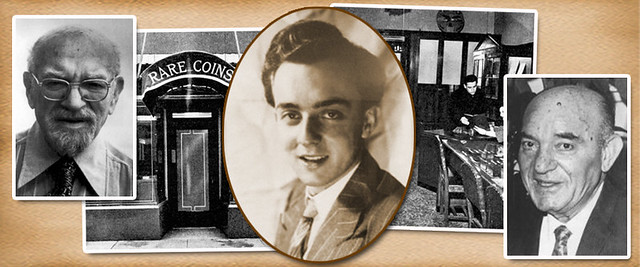
The year 1973 saw a number of initiatives in numismatics that brought about changes in the hobby. At Stack's these and other events made it a very active and important year for us. My son Lawrence R. Stack (Larry) joined the firm after his graduation from university. As a representative of Stack's, I worked with the Congress on the Hobby Protection Act and with the American Numismatic Association (ANA) to revamp the numismatic grading system to include numerical grading. As always, Stack's also had the privilege of offering at public auction important old time collections.
Inflation continued. Money became more available, but unfortunately lost some of its purchasing power. Markets, including the stock market, the commodities markets, and real estate markets showed signs that certain collectibles were coming into demand, and that people wanted to have alternate means of investment – a "store of value."
Meanwhile, professionals and collectors worked toward changes to make the hobby of numismatics more pleasurable, with less abuse by counterfeiters and promoters who tempted many to make bad investments.
1973 was a year when the importance and reliability of the professional numismatist was discussed and acted upon. It was a year where many worked to make the hobby more acceptable to old as well new collectors. New collectors of course needed guidance, but older more seasoned collectors could also use our assistance to grow with the hobby and to navigate the changes that were taking place.
Congress was receiving complaints about the lack of regulation, and the counterfeits that were made in the United States as well as many places worldwide. This affected not just numismatics but other areas of collectibles as well. They convened a hearing to review what the various industries would suggest. I was asked to be the representative for the coin hobby, this resulting from my earlier encounter with the Treasury regarding the temporary restriction of gold coin imports from abroad. I presented my case, which included advising Congress that counterfeit U.S. and world coins were flooding the country and we needed a way to regulate the inflow. The Custom House, I learned, was ill-equipped to identify and confiscate false coins. The law, which was finally enacted, said that all coins entering our markets that are false and counterfeit, had to be stamped, in letters that were easy to read, the word COPY!
The same problems, in different ways affected other collectibles, from ancient world items, to art, lithographs, porcelain china, jewelry, postage stamps and more. Buyers were having trouble with questionable items, and had immense difficulty getting their money back when they challenged them. Federal authorities had only limited ability to help – the Secret Service was involved with problems dealing with monetary items – but some kind of law enforcement was required.
The Hobby Protection Act was passed in 1973, turning much of the authority over to the Federal Trade Commission (FTC) to propose a set of regulations and to enforce rules. However, the FTC was not able to administer the law, for they were lacking in qualified experts to help write and enforce the law.
So while the law existed, as late as 2014 few if any regulations had been administered and enforced. To this day, other than the laws about counterfeiting (which have been on the books since virtually the time we became a nation), collectibles have not be regulated as the law provides. And while the gold import regulations of 1961 might have had some positive outcomes, they were arbitrary and capricious (as was determined in court) and the regulators were unable to administer the program effectively so they were terminated in 1967.
All of us who participated in the hearings knew that the problems existed, but also knew that apprehending the culprits was difficult. Few coins were stamped, thousands came to market, and the Secret Service has not been able to efficiently administer any regulation so the market had (and still has) many false, copies and counterfeit coins to deal with. But we keep trying!
To read the complete article, see:
Harvey Stack Remembers Growing up in a Numismatic Family, Part 60
(https://www.stacksbowers.com/News/Pages/Blogs.aspx?ArticleID=Harvey-Stack-Remembers-Part-60)
To read the complete article, see:
HARVEY STACK'S NUMISMATIC FAMILY, PART 59 (https://www.coinbooks.org/v22/esylum_v22n51a13.html)

THE NUMISMATIC LEGACY OF THE FRANKLIN MINT
Lou Golino published a great article January 3, 2020 on "The Franklin Mint's legacy for modern numismatics." Here are some excerpts, but be sure to read the complete article online - it's a very thorough treatment of all sides of the situation. -Editor
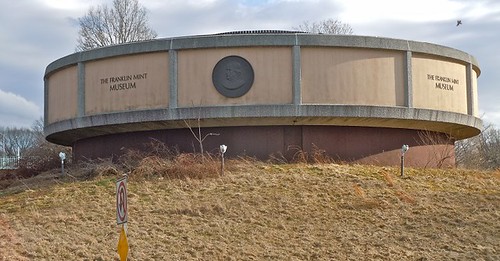
The since-demolished Franklin Mint Museum next to the former headquarters in Wawa, Pennsylvania.
For legions of American coin and medal collectors who came of age numismatically from the 1960s to 1980s, the Franklin Mint was a fixture of the hobby. Based in Wawa, Pennsylvania (outside Philadelphia), the company and its products were a staple of advertisements in newspapers and hobby periodicals for decades starting in the mid-1960s. The company, which later changed hands many times and no longer issues its own coins, but whose brand still exists today, was a significant commercial success during most of the past half-century with sales reaching over $1 billion in 2000.
But many of its collectible products were overpriced and eventually lost most of their premium over precious metal content, leaving its many customers dismayed at the amount of money they had lost. However, some buyers did well if they purchased silver items early on when silver was much less expensive than it would become over time, especially in January 1980.
And the mint, which, in its heyday in the 1970s and 1980s, was the largest privately-owned mint in the world and had a half million subscribers to its monthly magazine. It helped pave the way for the explosion of non-circulating legal tender commemorative coins issued in recent decades. It also impacted modern numismatics by setting the precedent of legal tender coins being issued by a private mint on behalf of other countries — a trend that continues to grow as numerous companies that specialize in bullion and collectors coins develop partnerships with mints around the world. In fact, some of the most popular recent coin series such as the Australian wedge-tailed eagle that debuted in 2014 and just launched its fifth design by former U.S. Mint Chief Engraver John Mercanti came into existence this way.
In addition, the mint helped to increase interest in collecting medals, which had fallen out of favor with collectors during the coin craze of the 1960s, and it was the first to use silver that had been to the moon to produce coins, another practice that continues to be used today.
The company's commercial success, including rising annual sales and a massive increase in the value of its stock, was based on several key factors. First, Segel had the foresight to purchase a large amount of silver bullion prior to the meteoric rise of the spot value of that metal in 1979-1980 and to hedge the metal later, which was essential when keeping the issue price of items stable over time. That would prove to be one of his best business decisions
See the complete article, linked below. The "Keys to Success" and "Lessons for Numismatics" sections are spot-on.
Here's a question for readers - would anyone have a complete run of the Franklin Mint's magazine? Perhaps the successor company would allow it to be digitized on the Newman Numismatic Portal, where it could be of use to future researchers. -Editor
To read the complete article, see:
The Franklin Mint's legacy for modern numismatics
(http://news.coinupdate.com/the-franklin-mints-legacy-for-modern-numismatics/)
WORTHPOINT FOUNDER WILL SEIPPEL
A number of readers subscribe to the WorthPoint web site for valuation information on art, antiques, and collectibles. Founder Will Seippel was recently interviewed for the Starter Story site. Here's an excerpt. -Editor
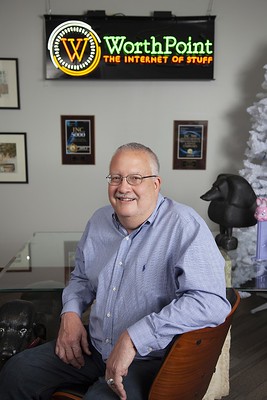 A tipping point occurred when my mother held a garage sale in Maine – some savvy dealers took advantage of her naiveté and practically stole some of her expensive coins
and Tiffany & Co. glass. I thought to myself, “The world needs a way to avoid costly mistakes of selling or buying an item at the wrong price!”
A tipping point occurred when my mother held a garage sale in Maine – some savvy dealers took advantage of her naiveté and practically stole some of her expensive coins
and Tiffany & Co. glass. I thought to myself, “The world needs a way to avoid costly mistakes of selling or buying an item at the wrong price!”
My goal in starting WorthPoint was twofold. First, I wanted to make it more efficient for anyone to find data on items they were selling via eBay or other sites, and second, I wanted to bring resources to the masses that would help identify, value, and preserve items in their home. The reselling of “used” items is one of the largest industries in the world – I would estimate the market at up to $1 trillion. Obviously, that is big business, and we wanted WorthPoint to be part of it.
We wanted to help people to precisely identify an item while democratizing pricing information and making it available to any collector who needed it. This wasn't happening in our industry, and we knew we could speed up the process. We set out to become our industry what Bloomberg is to the financial world.
Our customers are antique dealers, longtime and new collectors, professional or amateur pickers, insurance adjusters, and just about anyone with accumulated “stuff” that they want to research for values in seconds.
To read the complete article, see:
How I Built A $6M/Year Antiques & Art Database (https://www.starterstory.com/antiques-database)

LIBRARY OF CONGRESS EARLY AMERICAN PAPER MONEY
In his Coin World paper money column December 27, 2019, Arthur L. Friedberg pointed out a recent blog post by Anastasia Binkowski of the Rare Book and Special Collections section of the Library of Congress discussing the library's Early American Paper Money Collection, part of which is currently on exhibit at the library. Here's an excerpt from her article. -Editor
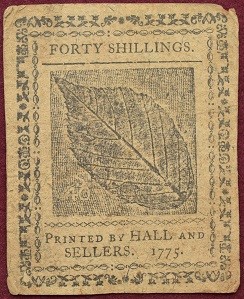 The Early American Paper Money Collection, newly rehoused in Rare Book and Special Collections at the Library of Congress, probably isn't like any money you've ever seen
before. These bills are roughly the size of a playing card, include fractional denominations like 1/6th of a dollar, and they aren't green. Of course, it isn't easy being green,
but it is easy to explore the collection using its finding aid here:
The Early American Paper Money Collection, newly rehoused in Rare Book and Special Collections at the Library of Congress, probably isn't like any money you've ever seen
before. These bills are roughly the size of a playing card, include fractional denominations like 1/6th of a dollar, and they aren't green. Of course, it isn't easy being green,
but it is easy to explore the collection using its finding aid here:
//hdl.loc.gov/loc.rbc/eadrbc.rb019001
The earliest paper money authorized by a government in the Western world was issued here in America, in the Massachusetts Bay Colony, in 1690. The earliest bill in The Early American Paper Money Collection was printed in 1746 for the Delaware colony by a name that may be familiar: Benjamin Franklin. Except for this early bill, the paper money printed by Franklin in the Library's collection is also attributed to his business partner David Hall. When Franklin eventually left the business to go abroad, Hall continued printing money with William Sellers. Franklin, Hall, and Sellers printed paper money out of the same shop for Pennsylvania, Delaware, Maryland, and New Jersey, as well as the Continental Congress. If you look at the back of many bills in the collection you will see “Philadelphia: Printed by Hall and Sellers.” Near those names you'll also see a detailed image of a leaf. This leaf isn't just a design element, it's an anti-counterfeiting tactic invented by Benjamin Franklin.
We know now, based on continued study and a surviving block for printing, discovered by the Delaware County Institute of Science and explained by James Green in the 2013 Annual Report of the Library Company of Philadelphia (p25–28), that it actually involved double-casting: creating a plaster mold of a leaf and pouring type metal into the impression. By casting first in plaster and then in metal, the resulting metal piece would have the same raised veins and texture of the original leaf and could be nailed to wood to make it the same height as the rest of Franklin's type. The details of this image would be incredibly challenging to copy by hand-engraving and the block itself would be impossible to duplicate without the exact same leaf and the knowledge of how to create both strong enough plaster and the right metal alloy. Despite all this, counterfeiters would ultimately devise a way, by transfer and tracing, to reproduce the look of these nature prints without having to cast anything.
 The most notable signature among the hundreds scrawled on this collection is probably that of John Hart. John Hart, (ca 1713–1779), was a farmer, judge, and public
servant in New Jersey who, after being elected vice president of the New Jersey Provincial Congress, also became a member of the Second Continental Congress just in time to make
history. Hart's name can be found on both the fifteen shillings bill from New Jersey, March 25, 1776 and the Declaration of Independence!
The most notable signature among the hundreds scrawled on this collection is probably that of John Hart. John Hart, (ca 1713–1779), was a farmer, judge, and public
servant in New Jersey who, after being elected vice president of the New Jersey Provincial Congress, also became a member of the Second Continental Congress just in time to make
history. Hart's name can be found on both the fifteen shillings bill from New Jersey, March 25, 1776 and the Declaration of Independence!
To read the complete blog article, see:
The Cost of Independence: Highlights from the Early American Paper Money Collection
(https://blogs.loc.gov/inside_adams/2019/11/early-american-paper-money/)
To read the Coin World article, see:
Library of Congress exhibit explores early American notes
(https://www.coinworld.com/news/paper-money/library-of-congress-exhibit-explores-early-american-notes)
THE BOOK BAZARRE
FRACTIONAL CURRENCY SHIELD ADVERTISER
While poking around the Library of Congress site I came across an unusual item I'm pretty sure I've never seen before - a U.S. Fractional Currency Shield printed with advertising. I was unable to locate a reference to it on the Newman Numismatic Portal. Has one of these been documented in numismatic literature or been sold in a numismatic auction? -Editor
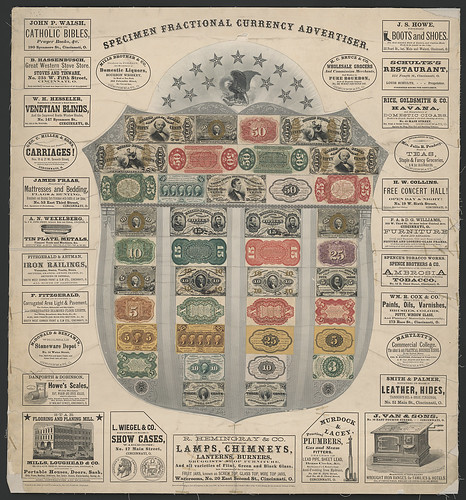
Title
Specimen fractional currency advertiser
Summary
Collage comprised of 39 engraved fractional currency specimen notes mounted on an engraving of the shield of the United States, with 13 stars and an eagle at the top, published by
the U.S. Treasury Department; the shield is framed by cutout in a sheet on which are printed 27 advertisements for businesses in Cincinnati, Ohio.
Contributor Names
John Tanner & Co., printer
Created / Published
Cincinnati, [Ohio] : Printed at the office of John Tanner & Co., No. 8 E. Fourth St., c1867.
Subject Headings
- Money--1860-1870
- Advertising--1860-1870
Format Headings
Advertisements--1860-1870.
Bank notes--1860-1870.
Collages--1860-1870.
Engravings--Color--1860-1870.
Letterpress works--1860-1870.
Notes
- Title from the printed border.
- Entered according to Act of Congress, in the year 1867, by John Stanton, in the Clerk's Office of the United States, for the Southern District of Ohio.
Medium
41 prints : letterpress and engraving, color, mounted on engraved sheet ; 62.5 x 53.5 cm (original currency shield sheet), 77 x 71.1 cm (sheet with advertising)
Call Number/Physical Location
PGA - Tanner (J.) & Co.--Specimen fractional ... (D size) [P&P]
Repository
Library of Congress Prints and Photographs Division Washington, D.C. 20540 USA http://hdl.loc.gov/loc.pnp/pp.print
Digital Id
pga 05848 //hdl.loc.gov/loc.pnp/pga.05848
cph 3a20397 //hdl.loc.gov/loc.pnp/cph.3a20397
Library of Congress Control Number
2014645288
Reproduction Number
LC-DIG-pga-05848 (digital file from original print) LC-USZ62-19142 (b&w film copy neg.)
Rights Advisory
No known restrictions on publication.
Language
English
Online Format
image
Description
41 prints : letterpress and engraving, color, mounted on engraved sheet ; 62.5 x 53.5 cm (original currency shield sheet), 77 x 71.1 cm (sheet with advertising) | Collage
comprised of 39 engraved fractional currency specimen notes mounted on an engraving of the shield of the United States, with 13 stars and an eagle at the top, published by the
U.S. Treasury Department; the shield is framed by cutout in a sheet on which are printed 27 advertisements for businesses in Cincinnati, Ohio.
LCCN Permalink
https://lccn.loc.gov/2014645288
To read the complete inventory entry, see:
Specimen fractional currency advertiser (https://www.loc.gov/item/2014645288/)
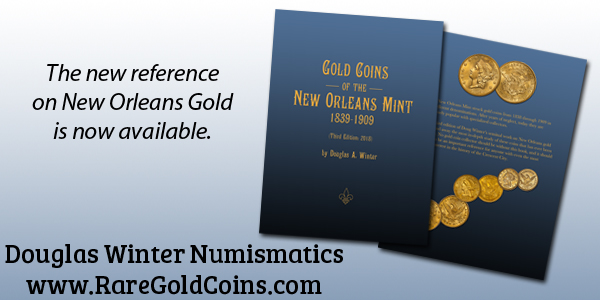
SAVING THE WASHINGTON FAMILY FORTUNE
Tom Kays calls for E-Sylum reader help in solving a money mystery of historic proportions. He recently met a representative of the Burke & Herbert Bank, a Burke family descendant who told a fascinating tale involving the bank and the Washington Family fortune. Can anyone help identify particular notes, checks, drafts, or financial instruments backing up the story? -Editor
Oliver Goddin is a descendant of the Burke family and a representative for the Burke & Herbert Bank. Oliver says his family has long told the tale of how John Burke, the bank's co-founder, and his wife helped save the Washington Family fortune at the outset of the American Civil War. One of President George Washington's descendants sold Washington's tomb, the Mount Vernon mansion house and two hundred acres in Virginia, just months before the start of the American Civil War, depositing the family fortune in Burke & Herbert Bank & Exchange in Alexandria, Virginia, before joining up with General Lee. How the Washington family fortune was raised, stashed, searched for, smuggled, and ultimately rose again is a true and fascinating tale with a dash of a mystery to this day of exactly how it was pulled off.
Burke & Herbert Bank
Burke & Herbert Bank has today become the oldest continuously operating bank in Virginia. John Woolfolk Burke and Arthur Herbert opened the Burke & Herbert Banking &
Exchange Office in August 1852, at Prince and Water Street (now called Lee Street) in Alexandria, a port city with busy Potomac River docks, warehouses, manufacturing, and
shipping. Alexandria had undergone retrocession from the District of Columbia (Washington City) back into the arms of the Commonwealth of Virginia in 1846-1847, allowing
Alexandria residents to seek financing for infrastructure projects, such as the new gas works and the Alexandria Canal, without interference from Congress.
Three banks were already doing business in Alexandria. John Burke was 27 years old in 1852. His second wife, Martha Jefferson Trist was Thomas Jefferson's great-granddaughter. Arthur Herbert was just 23, and yet they handled the purchase and sale of bank notes and coin, collection of sight and time bills, negotiation of loans, bonds, stock sales, public securities, real estate deals, and land warrants on commission.
In May 1861, six weeks after Confederate forces fired on Fort Sumter, troops seized and occupied Arlington and Alexandria, holding them throughout the Civil War. Eleven regiments of Union troops occupied Alexandria, quickly transforming the city into military outposts, hospitals, signal corps sites, and setting a terminus for the U.S. Military Railroad.
Virginians living in Alexandria had to make hasty decisions to decamp south or stay put. If they stayed put, they would have to live under constant suspicion of southern sympathies by the occupying forces. Arthur Herbert left to join the Old Dominion Rifles (Company H) of the 17th Virginia Infantry, CSA. John Burke remained in Alexandria, under house arrest, and later in jail, throughout the war, treated as a Confederate sympathizer.
The occupying troops orders were to search for, and seize war materiel including building materials, food, supplies, and valuable assets needed to conduct the war. Houses that went vacant became fair game for being torn down and their bricks used to house Union troops in new barracks and fortifications under construction in the outer defenses of Washington City. Yankee foragers meant business.
Union harassment of the Burke and Herbert families would continue throughout the war. John Burke would assert he did not know where his bank's money was when repeatedly interrogated by Union officers, yet the Alexandria Gazette would later report that depositors in the Burke & Herbert Banking & Exchange Office lost no money during the ‘War of Northern Aggression' and occupation of Alexandria. How did John Burke hide, preserve, and protect his bank depositor's money throughout the war from jail?
George Washington's Heirs
One depositor in Burke & Herbert's Bank & Exchange was John Augustine Washington III, great-grand-nephew of George Washington, and the last Washington family member to own
Mount Vernon. He was continually beset with sightseers wanting to see and tour the mansion, ask the typical tourist questions, and make a nuisance of themselves, expecting
extravagant southern hospitality, and slowing John's farm work. John posted NO TRESPASSING signs and notices. He required letters of introduction from dignitaries seeking to
enter the mansion and denied steamboat access to the Mount Vernon dock on the Potomac River.
Losing money at farming, John eventually embraced historical tourism as a potential money-making venture. He sold flowers, fruit, milk, hand-carved canes and wooden ‘Washington' trinkets to tourists. John still lost money with the tourists. He tried to sell the mansion and a few hundred acres to the Federal Government in 1853, seeking to make Mount Vernon and Washington's Tomb into the property of the nation. No sale. He offered the property to the Commonwealth of Virginia. Still no sale.
In April 1858, John finally accepted an offer from the Mount Vernon Ladies Association (MVLA) of $200,000 for the mansion, tomb, and 200 acres, in installment payments over five years. The sales contract put $18,000 down with the remainder to be paid in full by February 22, 1862. The MVLA authorized the first installment payment for $57,000 with interest and then another $10,000 in December 1858, leaving the remainder ($115,000) payable under three future installments, each due on Washington's birthday in 1860, 1861, and 1862.
In the summer of 1860, John Augustine Washington III moved to Waveland Plantation near Winchester, Virginia leaving money paid by the MVLA on deposit with Burke and Herbert. He joined the Confederate Army as a lieutenant colonel, serving as aide-de-camp to General Robert E. Lee and was killed on reconnaissance at Cheat Mountain in 1861. John is buried in what is now West Virginia. The Union command wanted to confiscate the Washington Family money and suspected it was hidden in the city of Alexandria.
Mount Vernon Ladies Association
The Mount Vernon Ladies Association (MVLA) is a non-profit organization that today preserves and maintains George Washington's Mount Vernon estate. The MVLA was founded in 1853 by
Ann Pamela Cunningham of South Carolina, who heard a scandalous description of the decrepit mansion from her mother, who steamed past on a riverboat, and thought both Mount Vernon
and George Washington's memory would soon be gone from a lack of upkeep, to her utter dismay. “If the men of America have seen fit to allow the home of its most respected
hero to go to ruin, why can't the women of America band together to save it?”
The MVLA sought voluntary contributions from a grateful nation to do their duty as guardians of our common Father's Tomb. The MVLA hosted birth night balls, fairs, talks, lectures, and fundraisers to buy George Washington's decaying mansion from the Washington family heirs to preserve George Washington's legacy. Appeals to history-minded citizens to contribute a dollar per adult and fifty cents per child per annum to the cause of historic preservation would add your name to that patriotic roll call of citizen supporters who love American history.
The MVLA formed “Regents” and “Vice Regents” across the country who formed “Clubs” for women within each State. Clubs would receive a copy of Gilbert Stuart's portrait of George Washington, famed in gold as a masthead to aid in lectures on historic preservation, with reform, temperance, and abolition subthemes for good measure. Their goal was to raise $500,000 to buy, restore, and maintain the mansion and grave site. The names, sum, and residence of any contributor were registered by the Association in the Mount Vernon Registry.
For instance, a lecture on “The Lights and Shades of the Irish Character” was delivered by Dr. Shelton Mackenzie, Literary Editor of “The Press,” at the Odd Fellows Hall in Norristown, Pennsylvania, to aid in MVLA fundraising. In Washington City, contributions were received in person at the Office of the Mayor of Washington, also by George W. Riggs, Esq., Treasurer of the MVLA. It was George W. Riggs who telegraphed Ann Cunningham when the first $57,000 installment payment to John Washington was complete.
From 1854 to 1861, and thanks to the ladies, mailing envelopes and medals depicting George Washington and Mount Vernon became popular with the American public. In 1860, the United States Mint opened an exhibition featuring one hundred thirty-eight separate medals bearing George Washington's likeness and issued a one hundred thirty-ninth, itself. Mint Director James Ross Snowden contributed his own ‘Washingtonia' collection to form the United States cabinet of Washington medals, amid the uproar in which rare coins, patterns, and medals were re-struck at the Mint under Snowden's after-hours urging.
The death of Martha Washington's grandson, George Washington Parke Custis, an antiquarian, in 1857, led to publication in 1860, of a series of essays, Recollections and Private Memoirs of George Washington, he had written about his step-father, which were edited by his daughter with the help of Benson J. Lossing. Lossing pioneered historical tourism to rediscover and report on Revolutionary War sites in the 1850s including Mount Vernon. He arrived with his letter of introduction for John but was disappointed to find no one home and little hospitality. He gathered sketches for steel engravings to illustrate his popular history books throughout the 1850s and 1860s.
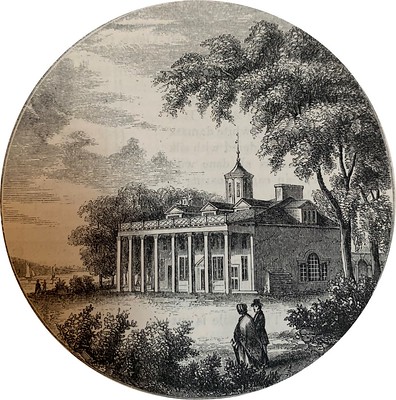
Idealized View of Mount Vernon, about 1860 by Benson J. Lossing, from the front Lawn looking south down the Potomac - This respectful steel engraving omits the sagging porch propped up by poles and disrepair evident on casual inspection from passers-by on the Potomac River.
The MVLA amazingly raised the full amount by February 22, 1860. The Mount Vernon Ladies Association took over conservancy of the ‘vacant' estate in 1860 after final payment, and before Southern Vice Regents began to have trouble sending restoration money as “cotton drafts” that local banks refused to cash. Ann Pamela Cunningham's directorship and fund-raising activities up north ceased in 1861, since she was trapped in South Carolina for the duration. The Mount Vernon mansion lay in “no-mans-land,' barely a few miles between Union and Confederate defensive positions, yet was spared from burning, dismantling, or disturbance by troops from North and South alike during the Civil War. In the MVLA Annual Report of 1866, George W. Riggs reported $1200 on account for maintaining Mount Vernon, short of the MVLA $300,000 goal for restoration and maintenance, but not entirely wiped out.
Hide and Seek with Bayonets
The Burke family received especially harsh treatment in a campaign to flush out hidden bank assets including the Washington family fortune. Conducting vigorous searches of
the Burke household, Union soldiers rampaged through the family's belongings until reaching a bedroom where Mrs. Burke stood by a closed door. “It is my closet,” she said,
“and you may search it if you must.” The Union commander, a gentleman, declined to search through the lady's intimate items and left. The bank's money was said to be
concealed under Mrs. Burke's neatly folded unmentionables. Would the next Yankee officer to search the house also be a gentleman?
John Burke had to get money out of Alexandria, but he was under house arrest, was no doubt being watched, and couldn't be found with it on his person. John called on Miss Sarah Cornelia Tracy, Secretary to the Mount Vernon Ladies Association's founder, Ann Cunningham, preservationist, and close friend of the Washington family. Miss Tracy was from New York, a Yankee, and a woman. She could travel across the lines. Sarah secreted money including the Washington family fortune in the bottom of a basket of eggs. Alone, she drove a one-horse cart past 75,000 Union troops, crossing the Potomac River to seek out Mr. Burke's trusted colleague, and Treasurer of the Mount Vernon Ladies Association, Mr. Charles W. Riggs, in Washington City living safely above the Potomac. Sarah is said to have stashed the fortune in a safe deposit box in the Northern Capitol to sit out the war, then calmly sold her eggs to Mr. Riggs, who we hear gladly paid for them. Burke family descendants have long told this story as family lore.
Miss Sarah occupied Mount Vernon during the war and later married Upton H. Herbert, the resident superintendent of Mount Vernon in 1872. General Winfield Scott gave the order to Union troops to approach with due reverence and leave uninjured the Tomb, Home, Groves, and Walks of Mount Vernon after a visit from Miss Sarah, who secured similar assurances from the Virginia Governor. Miss Sarah continued to receive visitors, let them tour the mansion house (provided they stacked their guns outside) and sold potatoes, peaches, pears, tomatoes, cabbages, hay, bricks, and photographs of Mount Vernon to get by.
Riggs & Company Bank
In 1836 William Wilson Corcoran opened a note brokerage house in Washington City. He joined with George Washington Riggs Jr., in 1840 to form Corcoran & Riggs, a private bank
which became the only Federal depository in Washington City by 1844, and who helped finance the War with Mexico by buying $16 million dollars or 80% of the bonds issued by the
U.S. Government to fight the war. Corcoran retired in 1854 leaving Riggs to change the institution's name to Riggs & Company, located across the street from the U.S. Treasury
Department.
Riggs handled accounts for both Abraham Lincoln and Jefferson Davis (then, Senator from Mississippi), offering checking and depository services. Banking back then was a bit more informal than today. For example, Abraham Lincoln wrote a check on Riggs & Company in April 11, 1863 for $5 payable to a “colored man with one leg.” It would be Riggs & Company that lent $7.2 million dollars in gold bullion to Secretary of State William Seward, who needed gold to purchase Alaska from Tsar Alexander II just after the war.
Questions for E-Sylum Readers
While I haven't yet made the connection that Charles W. Riggs worked directly for Riggs & Company, perhaps Riggs & Company is where John Burke arranged with Yankee
‘confederates' to preserve the Burke & Herbert depositor's money, including the Washington family fortune, finding safe keeping until after the war? Details of Burke &
Herbert Bank reconstruction and reopening remain sketchy. But in what form could the Washington Family fortune (more than $115,000 in the last installment of February 1860) fit in
an egg-basket?
U.S. Federal banknotes would not be printed until 1862 and new Confederate notes of 1861 would lose all value by war's end. Gold coin would be too heavy. Perhaps several hundred, $500 denomination, saddle-blanket-sized notes would fit unobtrusively under the straw lining Miss Sarah's egg basket? Does anyone know of, or have a specific example of notes used in MVLA fund raising, payments to the Washington Family for Mount Vernon, or Burke & Herbert issued bank notes of that age? In what form could pre-war, Virginia financial instruments cross the Potomac in an egg basket, fit in a safe deposit box, yet hold their value for the Washington family heirs throughout the Civil War? What wildcat banknotes would be redeemable on either side of the Mason-Dixon Line from the start to the end of the Civil War?
Oliver Goddin, who is John Burke's descendant, wants to know what to look for in the Burke & Herbert books, and perhaps down in the vault, from these thrilling events, to assign probable provenance to specific financial instruments from the Washington family fortune, arising from the MVLA's cause, and which helped enshrine George Washington's legacy for us today.
Perhaps what Miss Tracy took to Mr. Riggs was a financial instrument he, himself sent to John Washington, on the behalf on the MVLA. Charles W. Riggs was MVLA treasurer since the 1850s and telegraphed Ann Pamela Cunningham in South Carolina when the incremental money transfer completed in 1858. What better form of money than notes drawn on Riggs' own bank, sent to John Washington from the MVLA account, placed on deposit with John Burke in Alexandria, but returned a few months later with eggs to Mr. Riggs for safekeeping?
Riggs Bank was bought by PNC Bank. Perhaps the Washington Family fortune makes its appearance in the defunct Riggs & Company archives?
References:
• A Brief Glimpse of Alexandria History: Burke & Herbert Bank by Kris Gilbertson as published online by Zebra, November 15, 2015
• A Riggs Bank History: Ghosts, Good Business by Chapin Wright; The Washington Post, April 28, 1980.
• Burke & Herbert Celebrates 150 Years, by Julia M. Williams, Richmond, The Dietz Press, 2002
• John Augustine Washington III by Matthew Costello, Marquette University, The Digital Encyclopedia of George Washington online at mountvernon.org
• Early History of the Mount Vernon Ladies Association by Mary V. Thompson, The Digital Encyclopedia of George Washington online at mountvernon.org
• The Pictorial Field-Book of the Revolution, or Illustrations, by Pen and Pencil, of the History, Biography, Scenery, Relics, and Traditions of the War for Independence, by Benson J. Lossing, Volume II, Harper & Brothers, New York, 1860.
• The Illustrated Mount Vernon - The Mount Vernon Record – Dedicated to the Purchase of the Home and Grave of Washington, by the Mt. Vernon Ladies Association of the Union, Philadelphia, December 1858, at archives.mountvernon.org
• How Private Philanthropy Saved the Founder's Homes Mount Vernon and Monticello by Myron Magnet, Autumn 2011 – MVLA Magazine
• Sarah Tracy: Keeping Mount Vernon Safe by Jesse Biele, Patch, May 22, 2012 at Patch.com
• Personal Discussion with Oliver Goddin, a Burke family descendant
Thanks, Tom. Can anyone help resolve this fascinating mystery? See the 2006 E-Sylum article (linked below) for more information on the Riggs Bank archives. Later that year PNC donated the archives to The George Washington University. -Editor
To read the earlier E-Sylum article, see:
PNC BANK INVENTORIES RIGGS BANK ARCHIVES (https://www.coinbooks.org/esylum_v09n24a11.html)
For more information on the Riggs Bank Archives, see:
GW TO RECEIVE HISTORIC RECORDS FROM PNC-RIGGS BANK ARCHIVES VALUED AT MORE THAN $5 MILLION
(https://www2.gwu.edu/~media/pressrelease.cfm?ann_id=23591)
PNC-Riggs Bank Records (https://searcharchives.library.gwu.edu/repositories/2/resources/365)
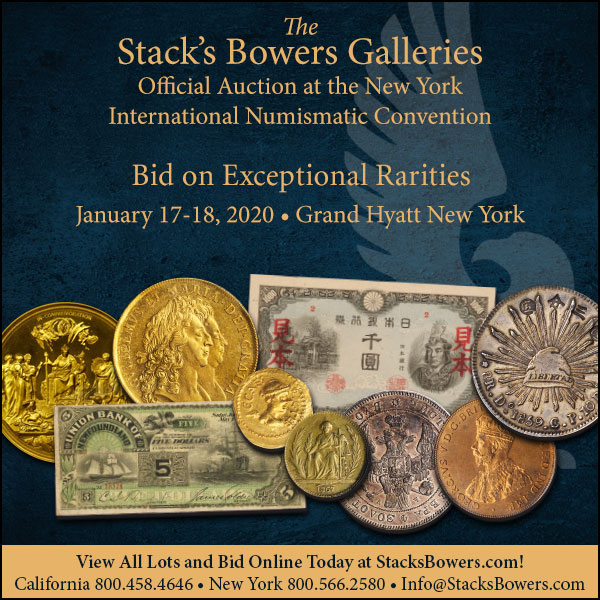
NUMISMAGRAM MEDAL SELECTIONS: JANUARY 2020
Jeremy Bostwick at Numismagram passed along these highlights from his New Year's upload of exonumia. In addition to the pieces below, this group—a rather broad assortment—includes two more rechenpfennigen Nürnberg, an absolutely blazing medal issued for the Apollo 11 mission and Moon landing, a couple Karl Goetz satirical bronze medals, a few attractive Art Deco pieces, an interesting aluminum plaque featuring three individuals important to Canadian history, a powerful piece honoring the children slain in the WWII Lidice massacre, a splendid Teddy Roosevelt repoussé pop-out badge on a Barber half dollar, and a few other great types. Visit numismagram.com/inventory for all of these new items. In addition, readers can take advantage of some reduced prices on some selections of inventory by checking out sale items listed at numismagram.com/sale. -Editor
Jonathan Martin Reliquary Snuff Box
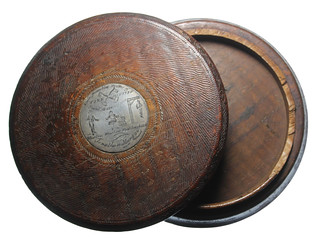
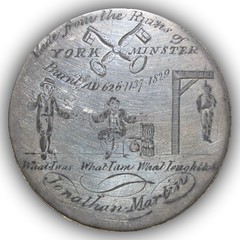
100920 | GREAT BRITAIN. York Minster wood & silver Reliquary Snuff Box Issued 1829. Condemning the arsonist, Jonathan Martin (133mm, 166.80 g). By P. Fossett in York.
Circular wood box with tapered rims and patterned top and bottom panels, the top panel containing a silver central medallion hand engraved as follows: "Made from the Ruins of / YORK MINSTER / Burnt AD 626 • 1137 • 1829 / Jonathan Martin." Crossed keys above; in the middle, three images of Martin, the arsonist—standing and preaching the Gospel: "What I was"—sitting imprisoned with a ball and chains: "What I am"—hanging from the gallows: "What I ought to be."
Choice Very Fine. Wood still features most of its intricate design; medallion once polished, now starting to re-tone; a few scattered marks; inner lip on base panel mostly broken, though some remains. Incredibly rare and interesting relic from the wood recovered in the aftermath of Martin's arson. Compared to other pieces of "hanging man" iconography, such as various trade tokens from the late 18th century, a bargain and a singular opportunity for such a tremendous and historic item.
Snuff tobacco originated in the Americas, an alternative to that which was smoked and as somewhat of an analog to that which was chewed. The tobacco was ground and, during each administration, a pinch was placed on the finger or hand and then sniffed by the user. In Europe, the practice became a status symbol associated with the elite and also created the need for containers in which the snuff could be easily carried by the user. Snuff boxes, therefore, became an indispensable form of accouterment, and offered designs ranging from the more mundane to the rather elaborate.
This particular snuff box was created from wood recovered from the parts of York Minster which were destroyed during a fire in 1829. Jonathan Martin had a history of extreme religious devotion and susceptibility to unpredictable outbursts. In between experiencing the deaths of his parents and wife, he served time in insane asylums and preached—first as a member of the Wesleyans, then unaffiliated as no denomination would support him. A year after remarrying in 1828, he suffered another mental breakdown, leading him to set a fire in the choir at York Minster, destroying a portion of the old cathedral. Owing to threatening notes which he left at the minster—containing his initials and address—it was rather easy to identify and apprehend him. During his subsequent trial, he was found guilty by a jury of a capital crime, though the judge countered this ruling, declaring him not guilty on account of insanity. Martin would then spend another stint in an asylum, this time for the remainder of his life until his death in 1838.
Numerous reliquary snuff boxes from the ruins of York Minster were created right after this act—an event which captivated the attention of England. Though many share a similarity in size and overall design of the wood, this particular box stands as rather extraordinary in the placement of the central medallion, engraved and illustrative of the contemporary sentiments of Martin the arsonist. While a few others simply feature text and a mentioning of the event, this incredible piece portrays the three phases of Martin—first in the past, as a preacher wandering the streets; second in the present, as a criminal clad in shackles; third in the future, as a lifeless body hanging from the gallows. Though quite gruesome (and inaccurate, even if it were the desired outcome by those angry of his crime), it portrays how despised he was by his fellow countrymen. Incredibly rare and quite possibly the only of its type.
A fascinating and very unusual item. -Editor
To read the complete item description, see:
100920 | GREAT BRITAIN. York Minster wood & silver Reliquary Snuff Box.
(https://www.numismagram.com/product-page/100920)
"Old Church Tijuana" Love Token
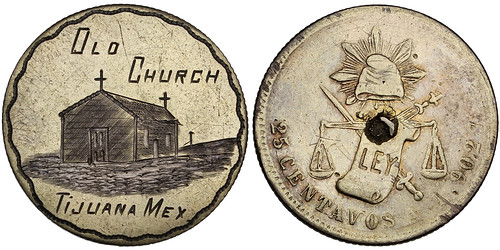
100982 | MEXICO. "Old Church Tijuana" silver Love Token. Engraved circa 1900 on an Alamos mint 25 Centavos (25mm, 5.97 g, 12h).
"OLD CHURCH / TIJUANA MEX" above and below perspective view of the "Old Church" at Tia Juana (Tijuana); all within coiled border / Scroll inscribed LEY over scales and crossed sword and scepter; rayed Phrygian cap above. Edge: Reeded.
Cf. KM 406 (for host coin). Engraving: Choice Extremely Fine; Host coin: Near Very Fine. Some scattered marks and soldering at center of the 'reverse.' An interesting piece of Mexicana and local art, all on a scarce mint host coin.
Being borrowed from the early 18th century practice in Great Britain, and being related to even earlier forms of engraving on European coinage, "love tokens" were an extremely popular form of sentimental art that saw their high point in the United States in the mid-to-late-19th century, whereby coinage was smoothed down on one or both sides, and some form of initials, a message, and/or imagery was engraved so that it may be presented to a loved one. The most commonly encountered 'canvas' in the United States was the dime, and usually one from the Seated Liberty series. At their height, the U.S. Mint blamed an alleged shortage of dimes—a staple of most late-19th century transactions—on this craze. Rising again in the early-mid 20th century during the depths of despair that were the world wars, this form of coin art, usually referred to in this context as "trench art," would see another revival, offering soldiers a brief chance at escapism through sentimental creativity.
This particular piece features the "Old Church" in Tijuana, an edifice which could not be located as still extant by this cataloger, but is featured—exactly as it was engraved here—on numerous postcards dating to the early 20th century. A charming representation of a humble southwestern church.
An interesting and unique piece. Plenty of love tokens have carved initials or monograms, but "trench art" scenes like this one are uncommon. -Editor
To read the complete item description, see:
100982 | MEXICO. "Old Church Tijuana" silver Love Token.
(https://www.numismagram.com/product-page/100982)
Pygmalion Copper Jeton
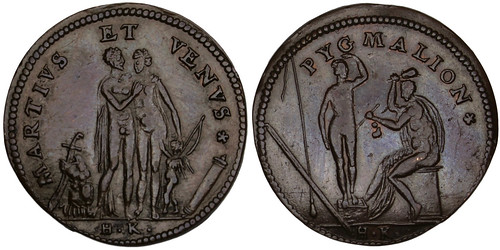
100942 | GERMANY. Nürnberg. Copper Jeton or Rechenpfennig. Issued circa 1600-1625. Mythology series: Mars and Venus/Pygmalion (28mm, 5.36 g, 12h). By H. Krauwinkel II.
MARTIVS ET VENVS, Mars and Venus standing facing, embracing one another; sword and cuirass to left, Cupid, bow, and quiver to right / PYGMALION, Pygmalion seated left on basis, hammering and chiseling a sculpture to left. Neumann 32273; Mitchener 1624-5.
Choice About Uncirculated. Pleasing brown surfaces; some minor striking weakness. Exceptional quality for the type.
Rechenpfennigen, German for "accounting pennies," are similar to other tokens or jetons that could serve reckoning, gaming, or even semi-numismatic functions. In particular, the rechenpfennigen were made famous by their various manufacturers in Nürnberg (Nuremberg) from the mid-late 16th century to the early 18th century, with a host of themes used as subject matter. These topics included history, mythology, contemporary political affairs, and even satire. Though many were intended as aids in accounting and bookkeeping (with an accounting board and these tokens taking the place of an abacus or sliderule), they were also useful in other functions, such as in the world of gaming—as poker chips—or in commerce and monetary transactions—as a substitute for harder currency.
A mythological type, this piece not only features Mars and Venus on the obverse, but also touches upon the story of Pygmalion, a sculptor famous in legend for falling in love with a sculpture produced by his own hand, it being so beautiful and realistic. In a modern reprisal, George Bernard Shaw's play of the same name sees phonetics professor Henry Higgins "sculpt" the diction of his student, Eliza Doolittle, thus "giving her life," in an upper class, social sense of early 20th century England. The musical and movie My Fair Lady remade Shaw's story, all pointing back to this original legend.
Interesting item and story. A crude design, but appropriate for a jeton. -Editor
To read the complete item description, see:
100942 | GERMANY. Nürnberg. Copper Jeton or Rechenpfennig. (https://www.numismagram.com/product-page/100942)
Scott Centennial Libertas Americana Token
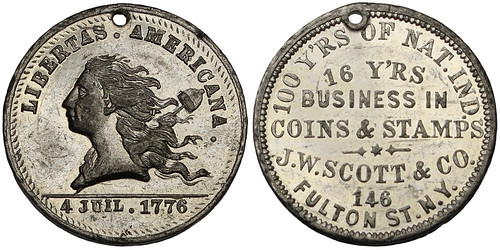
100937 | UNITED STATES. Libertas Americana/John Walter Scott white metal Token. Issued 1876. The centennial celebration (23mm, 4.29 g, 1h).
LIBERTAS AMERICANA / 4 JUIL 1776, head of liberty left, with free flowing hair and Phrygian cap on pole / 100 Y'RS OF NAT. IND. / 16 Y'RS / BUSINESS IN / COINS & STAMPS / J. W. SCOTT & CO. / 146 / FULTON ST. N. Y. in seven lines. Edge: Plain.
Miller NY-801; Rulau NY-NY-830. Mint State Details. Highly brilliant and lustrous, with some lightly scattered marks; holed at 12h for suspension. Restitution issue of the popular Libertas Americana type.
Designed in part by Benjamin Franklin, the popular "Libertas Americana" motif was thought of as emblematic of the fledgling, newly-established nation—wild and untamed, hopeful and, most importantly, free. Here, the allegorical Liberty exhibits free-flowing, unkempt hair, while a Phrygian cap—an ancient symbol throughout Thrace and Anatolia that later came to represent liberty—tops a pole over her shoulder. During the country's centennial celebrations in 1876, this national iconography was restituted on many tokens of medals, such as this storecard for the New York-based coin and stamp dealer, J. W. Scott.
Great numismatic Americana, produced by an important early coin dealer and publisher. -Editor
To read the complete item description, see:
100937 | UNITED STATES. Libertas Americana/J. W. Scott white metal Token.
(https://www.numismagram.com/product-page/100937)
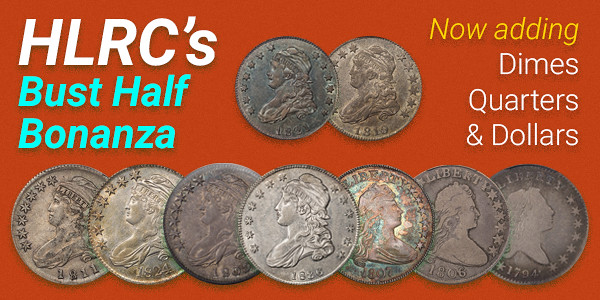
NUMISMATIC NUGGETS: JANUARY 5, 2020
Here's a selection of interesting or unusual items I came across in the marketplace this week. Tell us what you think of some of these. -Editor
1641 Reichstag Medal
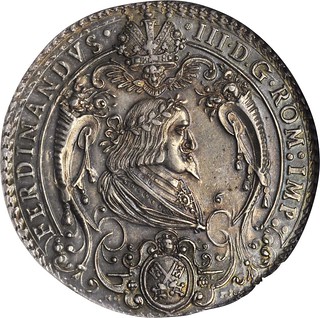
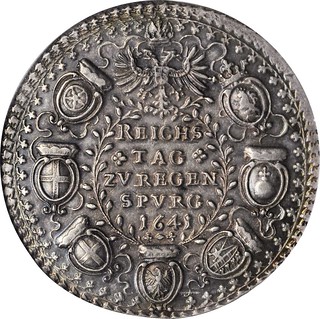
GERMANY. Regensburg. Silver Reichstag Medal, 1641. Ferdinand III. NGC MS-61.
43 mm. Mont-811. Medal engraved by Hans Georg Bahre. Struck to commemorate the opening of the Reichstag. Obverse: Laureate bust of Ferdinand III right flanked by intricate cornucopias, arms of Regensburg below, legend around; Reverse: Four line inscription with date below, all within wreath and circle of the coat of arms of the seven electors. The medal boasts a finely detailed high relief design displaying rich old cabinet patina.
A great medal from the Stacks Bowers January 2020 NYINC sale. -Editor
To read the complete lot description, see:
20366 GERMANY. Regensburg. Silver Reichstag
Medal, 1641. Ferdinand III. NGC MS-61. (https://auctions.stacksbowers.com/lots/view/3-L9PDS/germany-regensburg-silver-reichstag-medal-1641-ferdinand-iii-ngc-ms-61)
1835 Classic Head Half Cent
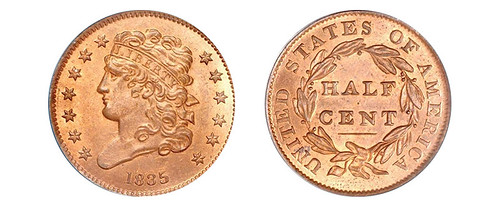
We first handled this piece over 15 years ago in our July 2004 sale of the Oliver Jung Collection. At that time, it was tied for the finest seen by PCGS in the Red category and it remarkably remains so today. In fact, our 2004 sale of the Jung Collection marks the last time a PCGS-certified MS-65 Red example has sold at auction.
This coin has since resided in the incredible ESM Collection, which is currently ranked as #3 among the all-time finest PCGS Registry Sets in the Circulation Strike Half Cents with Major Varieties category.
Blazing red! Beautiful piece. From a Stack's Bowers blog article by Senior Numismatist James McCartney. The coin will be offered in the firm's March 2020 Baltimore Auction. -Editor
To read the complete article, see:
Gem Red 1835 Classic Head Half Cent Featured in our March 2020 Baltimore
Auction (https://www.stacksbowers.com/News/Pages/Blogs.aspx?ArticleID=Gem-Red-Classic-Head-Half-Cent)
Theodore Roosevelt Repoussé Badge
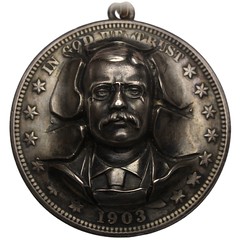
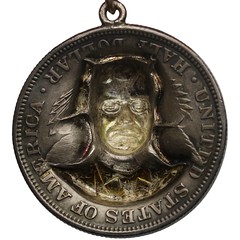
100972 | UNITED STATES. Theodore Roosevelt silver Repoussé Badge. Issued circa 1912 on a 1903-dated Barber Half Dollar (30mm, 13.17 g).
"Repoussés" are an interesting form of coin art appearing in the early part of the 1900's. The host coin was heated to a very high temperature, thus softening the metal and making it a candidate for "re-punching." Dies with a facing (usually) head of some kind would take the place of the original device on the obverse, with an incuse version of this obverse design now evident on the reverse. The result would offer a tremendous 3-D effect, whereby the face on the coin was seemingly bursting out of the piece. In reality, the process was simply an update of the bracteates that used to circulate in areas such as medieval Germany and Switzerland—the coins merely having an obverse design, with the reverse being an incuse, inverted version of the obverse. In the case of this piece, the Roosevelt "pop-out" was likely issued during one of "TR's" presidential campaigns—possibly that of 1912 when he ran under the third party Bull Moose ticket—for which these could have served as political badges.
These are most commonly seen with a Liberty Head design. This is the first I've ever seen with Teddy Roosevelt, or any political candidate for that matter. Cool item. From Jeremy Bostwick's Numismagram site. See more of his exonumia stock in an article elsewhere in this issue. -Editor
To read the complete item description, see:
100972 | UNITED STATES. Theodore Roosevelt silver Repoussé Badge.
(https://www.numismagram.com/product-page/100972)
Bendix Electronics Spinner Medal
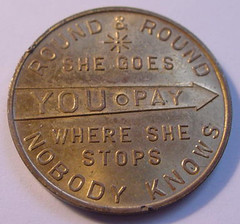
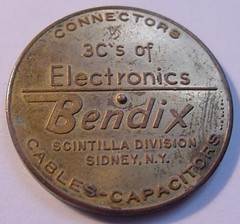
Cool little "spinner". The raised dot in the center of the reverse lets you spin the piece on a tabletop. Fun way to choose who buys the next round of drinks. -Editor
To read the complete lot description, see:
Lot 232: BENDIX ELECTRONICS MEDAL (https://www.invaluable.com/auction-lot/-1-c-B3D4630B84)
HASMONEAN COINS UNEARTHED IN SHILOH
John Lupia, Arthur Shippee and Aaron Oppenheim forwarded this Jerusalem Post article about another coin find in Israel. Thanks! -Editor
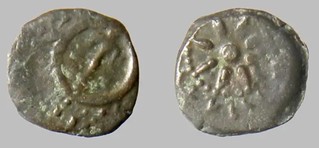 A wet sifting project in ancient Shiloh has led to the discovery of some 20 ancient coins this week as the world marked the final days of Hanukkah.
A wet sifting project in ancient Shiloh has led to the discovery of some 20 ancient coins this week as the world marked the final days of Hanukkah.
The find was made by the Associates for Biblical Research, directed by archaeologist Dr. Scott Stripling. It was announced on Monday.
According to Stripling, more than half of the coins date back to the Hasmonean period, to the ruler Alexander Jannnaeus and his successors, which makes the coins about 2,000 years old.
Jannnaeus was the second king of Judea. He ruled from 103 to 76 BCE, inheriting the throne from his brother Aristobulus I.
“Shiloh was occupied during the Hasmonean period, during the late Second Temple period, through the Hasmonean period, to the end of the Herodian period and onto the first period up until 70 CE,” Stripling told The Jerusalem Post on Sunday. “It was occupied during that period, and that's why we've found so many of those coins. But also they continued in circulation even after the Maccabeans because they were so popular; once the Jewish state lost its independence to Rome in 63 BC, those coins were sort of a type of passive resistance to Rome.”
Because of this, people continued to use them for generations, he said. “The ones that we found, because we find a lot of these coins, were found during a wet sifting project where we go through old piles of dirt to see what was missed in the past,” he said. “So these came from our wet sifting project that we're working on this winter.”
For Katsof and his supporter, “We were blown away. We were walking around the mountains of Shiloh, and right in front of us they found this coin on Hanukkah – on the last candle of Hanukkah. “We were talking about the battles of the Hasmoneans, and we found a Hasmonean coin right in front of eyes,” he said, adding that the group had been looking all day and hadn't found coins, “and boom, they found right in front of us.”
“For me, it was very special,” Katsof said, joking that this was “real Hanukkah gelt.”
To read the complete article, see:
2,000-year-old Hasmonean coins unearthed in Shiloh over
Hanukkah (https://www.jpost.com/Israel-News/2000-year-old-Hasmonean-coins-unearthed-in-Shiloh-on-Hanukkah-612567)
RESTRICTIVE TURKEY, TUNISIA AGREEMENTS PENDING
Mark Fox submitted this article about potential agreements with Turkey and Tunisia which could have a large impact on coin collecting in the U.S. Thanks! -Editor
U.S. Considers Restrictive MoUs with Turkey and Tunisia Affecting Coin Collecting
by Mark Fox
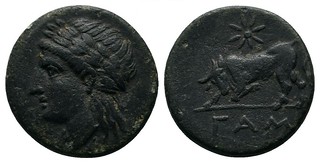 To be fair, the anticipated Turkish Memorandum of Understanding (MoU) with the US, received by the government on October 2 of last year, did not specifically state its
desire to see US import restrictions applied to coins, but it is all but assured, given Turkey's lengthy list of general wants. The public summary of the request can be read here:
To be fair, the anticipated Turkish Memorandum of Understanding (MoU) with the US, received by the government on October 2 of last year, did not specifically state its
desire to see US import restrictions applied to coins, but it is all but assured, given Turkey's lengthy list of general wants. The public summary of the request can be read here:
https://eca.state.gov/files/bureau/turkey_cpa_request_public_summary.pdf
For the Tunisian request, received on November 26, coins are plainly mentioned:
https://eca.state.gov/files/bureau/tunisia_request_public_summary.pdf
What is particularly problematic this time around are the scopes of the requests, which encompass archaeological material from prehistorical times to a large slice of the 1700s A.D., and the countries making them, which collectively comprise an enormous chunk of coin-issuing history. We are talking about billions of coins of Punic, Persian, Greek, Roman provincial and imperial, Byzantine, and Ottoman type, not to mention doubtless other types such as perhaps Vandal.
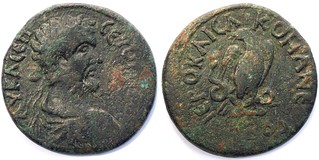 If the requests are accepted in their entirety, including what is not explicitly stated, then we may start feeling the negative effects of these and previous bilateral
agreements on a more personal level. The logic behind this is that U.S. Customs may feel they need less numismatic knowledge to sort through restricted and non-restricted coin
types, leading possibly to a less careful—and more regular—policy of detainment and confiscation. Most Greek-inscribed ancient coins, the majority of Byzantine coinage (who would
have thought we could get to an extreme like that?), and a large portion of Constantinian and other late Roman bronzes (LRBs), would all suddenly be vulnerable import items
without proper export permits and/or documentation (giving evidence of their presence outside the source country before the implementation date of a given MoU).
If the requests are accepted in their entirety, including what is not explicitly stated, then we may start feeling the negative effects of these and previous bilateral
agreements on a more personal level. The logic behind this is that U.S. Customs may feel they need less numismatic knowledge to sort through restricted and non-restricted coin
types, leading possibly to a less careful—and more regular—policy of detainment and confiscation. Most Greek-inscribed ancient coins, the majority of Byzantine coinage (who would
have thought we could get to an extreme like that?), and a large portion of Constantinian and other late Roman bronzes (LRBs), would all suddenly be vulnerable import items
without proper export permits and/or documentation (giving evidence of their presence outside the source country before the implementation date of a given MoU).
Of course, the bitter icing on the whole cake is the now regular move to also restrict modern coins. In the current cases, Ottoman types will be the most likely targets, although due to the fact that few Westerners can read Arabic, many other kinds of similarly-inscribed coins will likely attract misplaced suspicion.
This is the strange world we are now living in, where a previously criminalized drug has been effectively decriminalized, and a popular, educational, and formative pastime is being slowly criminalized without any external helps to adapt it which are not punitive in nature.
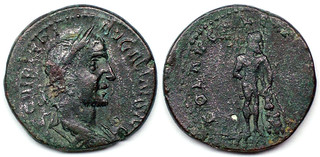 With a hope and eye toward challenging the current grave situation affecting our hobby and scientific research, scholars, numismatics, and collectors not only in the US,
but everywhere on the globe, are seriously urged to contribute a simple electronic public comment to help change the otherwise certain outcomes later this year. Interested parties
can do so by entering the docket DOS-2019-0043 at http://www.regulations.gov and clicking on the “Comment Now!” button.
With a hope and eye toward challenging the current grave situation affecting our hobby and scientific research, scholars, numismatics, and collectors not only in the US,
but everywhere on the globe, are seriously urged to contribute a simple electronic public comment to help change the otherwise certain outcomes later this year. Interested parties
can do so by entering the docket DOS-2019-0043 at http://www.regulations.gov and clicking on the “Comment Now!” button.
More info on the current MoUs and instructions on what points should be addressed in electronic comments can be found at:
http://culturalpropertyobserver.blogspot.com/2019/11/please-comment-on-proposed-mous-with.html
Please don't brood over the possible futility of such an exercise. Please instead send a respectful comment by 11:59 P.M. (EST) on January 7, the time and date of the swiftly-approaching deadline. Even if you are of the opinion that import restrictions on coins would be beneficial in the long run, still say something! As of this writing (January 3), only a mere eleven electronic comments were publicly noted as received by the U.S. Department of State (DOS). This may be our last easy chance to effect meaningful change to the current, numismatically-harsh climate.
Above are a few relevant photos of coins in my collection.
1. Mysia, Gambrium (Gambrion). 4th Century B.C. Æ 17mm, 2.74 g.
2. Pontus, Comana. Septimius Severus (A.D. 193–211). Æ 29mm, 12.37 g., 12h.
3. Troas, Alexandria Troas. Trebonianus Gallus (A.D. 251–253). Æ 22.33mm, 6.32 g, 12h.
For a more complete picture of the coins that Turkey and Tunisia would undoubtedly like to see mostly barred from entering the US, I have selected a few example types from the CNG archives.
TUNISIA
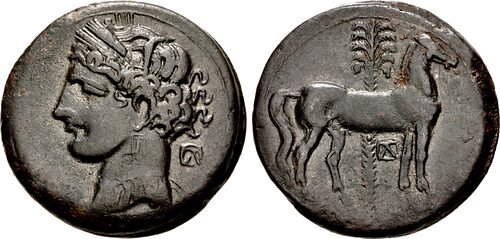
https://www.cngcoins.com/Coin.aspx?CoinID=387652
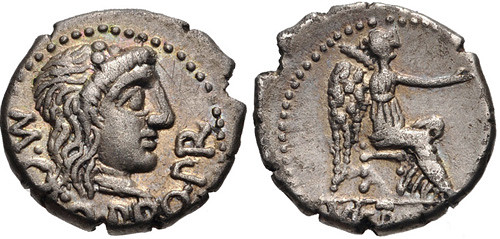
https://www.cngcoins.com/Coin.aspx?CoinID=211384
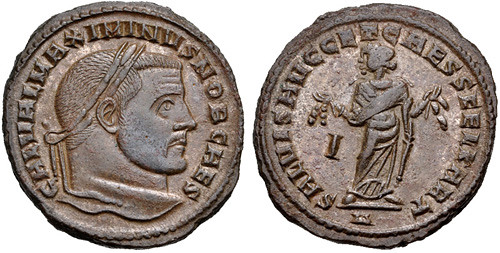
https://www.cngcoins.com/Coin.aspx?CoinID=327040
TURKEY
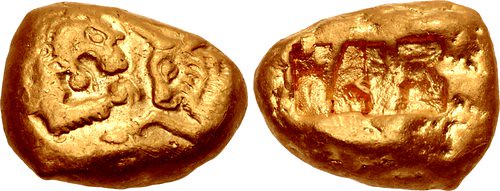
https://www.cngcoins.com/Coin.aspx?CoinID=365167
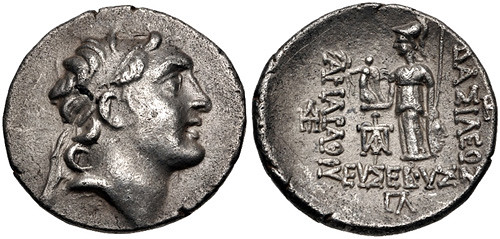
https://www.cngcoins.com/Coin.aspx?CoinID=375440
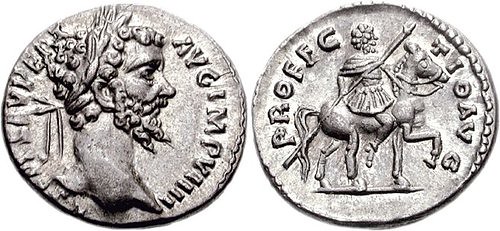
https://www.cngcoins.com/Coin.aspx?CoinID=97075
NATIONAL GALLERY ACQUIRES CHARLES I GOLD MEDAL
Anne Bentley of the Massachusetts Historical Society forwarded this article about the National Gallery of Art's recent acquisition of a gold Charles I medal. Thanks! I hadn't seen this. Great medal! -Editor
![The Juxon Medal: Charles I, 1600-1649, King of England 1625 [obverse]](https://c1.staticflickr.com/1/768/49331041856_fe864ab561_w.jpg)
Nicolas Briot, The Juxon Medal: Charles I, 1600-1649, King of England 1625 [obverse], 1639, gold, cast and chased, Gift of Drs. Yvonne and A. Peter Weiss, 2019.117.1.a
The Gallery has received an extremely rare gold medal of King Charles I from Drs. Yvonne and A. Peter Weiss. In addition to being unique and of outstanding quality, the medal was the personal possession of the king. He gave it to his confessor, William Juxon, bishop of London and future archbishop of Canterbury, in the tense weeks before Charles's execution in 1649. The medal has an unbroken provenance from today until 1639, when it was produced at the king's behest by his official medalist, Nicolas Briot (c. 1579–1646).
Known as "Dominion of the Seas" or "Sovereign of the Seas," the medal may refer to Charles's assertion of monarchical authority over the sea or his commissioning of a warship by that name. Five versions of the medal are known, all showing the king on the obverse and a ship on the reverse. These versions can be easily distinguished by their differences in size (ranging from 27 millimeters to 60 millimeters), material (lead, bronze, silver, and gold), inscription, and depiction of the king. Cast in a gold alloy, this acquisition is by far the largest, at 60 millimeters, and the most detailed. On the obverse, Charles is depicted in profile and dressed in armor with lion's-head pauldrons, a soft collar, and the Lesser George (an insignia of the Order of the Garter) around his neck. The ship depicted on the reverse is thought by some scholars to represent the Sovereign of the Seas, which launched in 1637 and was the largest warship in the Royal Navy—emblematic of Charles's effort to restore Britain's maritime power.
To read the complete article, see:
Acquisition Highlights (https://www.nga.gov/collection/recent_acquisitions.html)
LOOSE CHANGE: JANUARY 5, 2020
Here are some additional items in the media this week that may be of interest. -Editor
Don't Eliminate the U.S. Cent
On his JET Numismatics blog this week Jack Topping wrote about the lowly U.S. Cent. -Editor
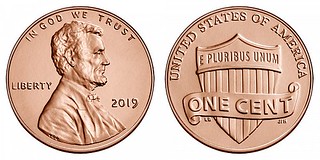 As the year comes to a close, I took a moment to look at the United States Mint's 2019 production numbers for the one cent coin, commonly referred to as the “penny”. The
overall number for circulating pennies surprised me, totaling at “6838.4M”, or in other terms, 6,838,400,000 one cent coins for this year alone. These figures, taken from the U.S.
Mint's Production Sales Figures page on their website tally up 3.352 billion and 3.486 billion pennies from the Denver and Philadelphia mints, respectively.
As the year comes to a close, I took a moment to look at the United States Mint's 2019 production numbers for the one cent coin, commonly referred to as the “penny”. The
overall number for circulating pennies surprised me, totaling at “6838.4M”, or in other terms, 6,838,400,000 one cent coins for this year alone. These figures, taken from the U.S.
Mint's Production Sales Figures page on their website tally up 3.352 billion and 3.486 billion pennies from the Denver and Philadelphia mints, respectively.
While I am not in favor of eliminating the penny, I think the number is honestly beyond comprehension. To put this in perspective, one billion seconds amounts to 31.69 years. Take a second and try to picture that in pennies.
Even though the buying power of the one cent coin is considerably low, it still is an opportunity for new collectors to enter the hobby. Collecting Lincoln Memorial and Lincoln Shield cents is a great and relatively inexpensive way to start a collection. As someone who started their collection with Lincoln cents, they hold a special place in my collection, yet at the same time it's important to recognize where these cents stand in public opinion. Even as a coin collector, I can recognize that nearly seven billion coins per year is a lot, knowing full well that it's proportional to the millions of citizens living in the United States.
Instead of producing billions of pennies annually (keeping in mind they are produced at 2.08 cents each as of 2018) the penny should continue to exist in the American economy, but new pennies should not be produced for circulation. Instead, a small amount (relative to 2019's nearly seven billion figure) could be minted to provide numismatists and enthusiasts alike to continue their collection, while at the same time alleviating unnecessary cost to taxpayers.
To read the complete article, see:
“Penny For Your Thoughts: Don't Eliminate the U.S. Cent” by Jack Topping
(https://jetnumismatics.com/2019/12/31/penny-for-your-thoughts-dont-eliminate-the-u-s-cent/)
New Brunswick Banknotes Up For Auction
The CBC News published an article about a collection of New Brunswick banknotes being auctioned this month by Heritage. -Editor
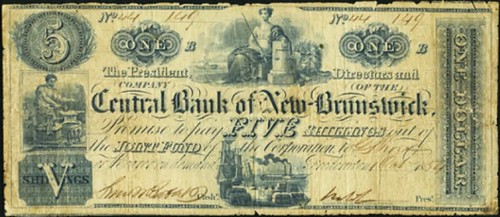
In the market for some old Canadian cash, say from the Westmorland Bank, established in The Bend of the Petitocodiac before it became Moncton?
More than 100 New Brunswick banknotes from the mid-1800s are going to be auctioned off to the highest bidder in Florida next week.
The banknotes belong to the collection of Rick Johnston, a Doaktown native who now lives in Calgary.
To read the complete article, see:
'A little bit of history': New Brunswick banknotes up for auction
in Florida (https://www.cbc.ca/news/canada/new-brunswick/history-new-brunswick-banknotes-auction-1.5412632)
Judge's Ruling Could Boost Vegan Challenge to Tallow Use
An article in The Telegraph revisits the issue of vegan complaints against the minuscule amounts of animal fats uses in the production of polymer banknotes. -Editor
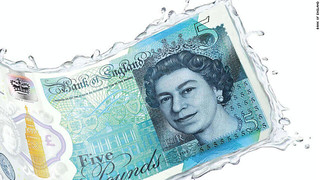 The Bank of England could face a legal challenge from vegans over its use of animal fats in banknotes, lawyers warned after a landmark ruling on Friday.
The Bank of England could face a legal challenge from vegans over its use of animal fats in banknotes, lawyers warned after a landmark ruling on Friday.
An employment judge found that holding a sincere belief in “ethical veganism” should be given the same legal protection under the Equality Act as that given to Christians, Jews and Muslims.
The legal team defending the vegan said after the hearing that animal rights activists could now even try to obtain a judicial review into whether the Bank of England's use of tallow in £5 and £10 notes constitutes indirect discrimination against their devout beliefs.
There was widespread condemnation from vegans two years ago after it emerged trace elements of animal fats were used in a polymer to coat new banknotes. The plastic is intended to prevent the counterfeit production of money, as well as make the notes smooth to the touch.
Although the tallow makes up less than one per cent of a banknote, members of numerous religious faiths were outraged that its use “discriminated” against their requirement to abstain from pork and beef products.
To read the complete article, see:
Vegans could legally fight 'unethical' banknotes
following landmark ruling (https://www.telegraph.co.uk/news/2020/01/03/vegans-could-legally-fight-unethical-banknotes-following-landmark/)
To read earlier E-Sylum articles, see:
NEW POLYMER NOTES CONTAIN ANIMAL FAT (https://www.coinbooks.org/esylum_v19n49a29.html)
MORE ON ANIMAL FAT IN THE POLYMER BANKNOTES (https://www.coinbooks.org/esylum_v19n50a34.html)
BLOG: VEGANS GO OVERBOARD WITH POLYMER NOTES (https://www.coinbooks.org/v20/esylum_v20n03a23.html)
Cash-Sniffer Catches Casablanca-Bound Couple
A cash-sniffing dog rooted out undeclared cash as a couple boarded a plane at Dulles airport recently. -Editor
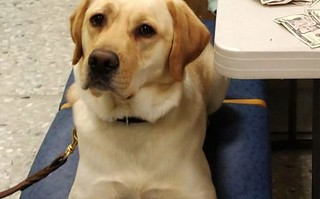 U.S. Customs and Border Protection officers at Dulles Airport have nabbed yet another traveler attempting to smuggle unreported currency out of the United States.
U.S. Customs and Border Protection officers at Dulles Airport have nabbed yet another traveler attempting to smuggle unreported currency out of the United States.
It is legal to carry large sums of currency into or out of the United States. However, federal law requires that travelers who possess $10,000 or more in currency or other monetary instruments to report it all to a CBP officer at the airport, seaport, or land border crossing when entering or leaving the country.
In the latest seizure, a couple destined for Casablanca, Morocco on Dec. 28 acknowledged that they understood federal currency reporting requirements and reported verbally and in writing that they possessed $8,000. CBP currency detector dog Cato alerted to their carry-on baggage and officers discovered additional currency. In total, CBP officers discovered $19,651. Officers seized $19,000 and released $651 to the couple for humanitarian purposes and allowed them to continue their trip.
To read the complete article, see:
K9 Cato, CBP Officers Seize Unreported Currency at Dulles Airport
(https://loudounnow.com/2020/01/03/k9-cato-cbp-officers-seize-unreported-currency-at-dulles-airport/)
FIGHTER JET SCULPTURE MADE OF CENTS
Justin Perrault passed along this Atlas Obscura article about a fighter jet sculpture in Virginia made of 14,000 cents. Thanks! Cool. -Editor
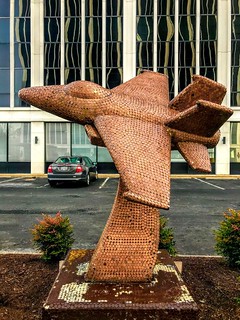
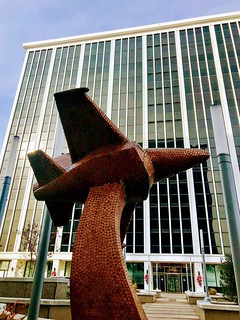
Parked indefinitely between two Falls Church City office buildings is perhaps the only plane in the Washington, D.C. area that you can access without waiting in dreadfully long airport security lines. This plane, a statue created in early 2008 by artist Courtney S. Hengerer of Alexandria, Virginia, stands more than six feet tall and is covered entirely in pennies—14,000 of them, to be exact. Hengerer titled her work, which resembles a fighter jet, “Pennies from Heaven.”
According to a 2018 Washington Post article, this plane-shaped art was originally designed as part of a “statue event” campaign of the nearby Crystal City Business Improvement District. To commemorate Crystal City's connection to flight (being located near Reagan National Airport and home to offices of several aerospace corporations), 50 artistic works representing planes, including “Pennies from Heaven,” were commissioned in early 2008.
When the Crystal Flight campaign ended, the plane statues were sold and BB&T bank obtained the distinctive “Pennies from Heaven” work of art. BB&T later relocated its offices to the Falls Church Corporate Center, and the penny plane took flight to its present location.
The plane itself is in great shape, though after a decade is understandably missing a few pennies. If you look closely, you will see that the pennies covering most of the plane are glued with Lincoln's head showing, but those on the rear stabilizers—the tail end of the plane—are tails up.
If you're up for a challenge, try to find the six United Kingdom pennies intermixed among the Lincoln cents, sporting three different images of Queen Elizabeth II. Another challenge, not for the impatient, is to find the oldest penny on the statue.
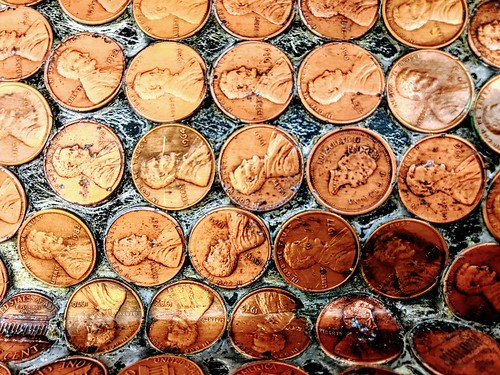
To read the complete article, see:
'Pennies from Heaven' (https://www.atlasobscura.com/places/pennies-from-heaven)

